- Question Papers
- Scholarships

List of 200+ Healthcare & Medical Presentation Topics
This is a comprehensive list of more than 200 healthcare and Medical Presentation Topics is useful for Powerpoint PPT & Paper Presentations. These topics can be used for webinars, Seminars, conferences, oral presentations, speeches and classroom presentations
Students of MBBS, BAMS, BHMS, B Pharmacy, D Pharmacy, M Pharmacy, Bio-Technology and other medical and healthcare streams can get the benefit of this list of medical presentation topics.
Below is the list of Healthcare & Medical Topics for Presentation.
Abdominal Trauma
Abuse and Neglect
Adult Day Care
Ageing/Geriatrics
Air and community health
Airway Management and Ventilation
Allergies – Anaphylaxis
Alzheimer’s Disease
Ambulance Operations
Artificial respiration
Analysis of qualitative data
Analysis of quantitative data and approaching the families in Community
Attention Deficit Disorder
Aquatic Therapy
Assessment-Based Management
Autonomic nervous system & Peripheral nervous system
Behavioural sciences & their relevance to Community Health
Babysitting
Bacterial Vaginosis
Behavioural and Psychiatric Disorders
Biochemical characteristics of cancer
Biosimulation
Bio-statistics in Health
Bioterrorism – WMD
Birth Control for Moms
Blood Borne Pathogens
Breast Cancer
Breastfeeding & weaning & Baby-Friendly Hospitals Breastfeeding promotion
Cancer/Radiation Therapy
Cardiovascular system
Case-Control Studies
Cataract Surgery
Causation & association
Central nervous system
Childhood Obesity
Children’s Health
Cholesterol
Clinical forensic medicine
Clinical Decision Making
Cohort studies
Collection of data – sampling methods, the sample size
Collection of vital statistics in the community
Commonwealth Health Corporation
Commonwealth Health Foundation
Commonwealth Health Free Clinic
Communications
Community organization in rural and urban areas – community participation
Concepts in Community Health
Creatinine Blood Test
Crime Scene Awareness
Cross-Sectional Anatomy
Culture, habits, customs and community health
Customised treatments
Deep Vein Thrombosis Awareness
Demographic trends in India.
Designing interview schedules – KABP studies
DNA repair mechanisms and related disorders
DNA Replication,
DNA Sequencing for Routine Checkups
DNA Transcription
Documentation
Drive-Thru Clinics
Ears, Nose and Throat Disorders
EMS Systems Roles and Responsibilities
Endocrine System and Individual Endocrine Glands
Endocrinology
Endoscopic Ultrasound: New Diagnostic and Therapeutic Applications
Environment and community health
Environmental toxicology
Environmental Conditions
Epidemiology as a tool for community health
Expanding Surgical Options for Lung Cancer Treatments
Eye banking & ethics in ophthalmology
Family and its role in health and disease
Family planning methods: permanent methods
Family planning methods: spacing methods
The fate of the antigen-antibody complex
Fertility & fertility-related statistics
Fitness/Exercise
Food habits, customs related to pregnancy, childbirth & lactation
Food Hygiene, Food Adulteration & Food poisoning
Forensic medicine & toxicology
Forensic psychiatry
Gastroenterology
Gastrointestinal System
Genetic Engineering: Recombinant DNA technology
Gynaecology
Hazardous Materials Incidents
Head – Facial Trauma
Health care of special groups: Adolescents & School Children
Health Education Tools & Audio-visual aids
Health hazards faced by agricultural workers
Health Planning in India
Health problem associated with urbanization & industrialization
Health seeking behaviour – barriers to health
The health situation in India
Healthcare Careers
Healthy Lifestyle
Heart Attacks in Women
Heart Disease
Heart Disease & Stroke Risk Factors
Haematology
Haemorrhage and Shock
Haemorrhoids
High Blood Pressure
High-risk strategy & risk factors in pregnancy & childbirth
Histology of various organs/organ systems
History of The Medical Center
History Taking
Home Health Care
Home Medical Equipment
Hospitals at home
Human sexuality; sex and marriage counselling
Hybrid Approach to Coronary Artery Disease
Hypothermia and its clinical applications
IEC & Health Education Strategies
Illness and Injury Prevention
Immunization for international travel
Indoor environment and health
Industrial toxic exposures
Infant & Child Mortality
Infant Care (Safety, CPR, Birth)
Infectious Diseases
Infectious – Communicable Diseases
Introduction to Maternal & Child Health
Jet-Set & Suture
Joint Replacement
Kidney Failure
LASIK (Eye Procedure)
Life tables and life table techniques for evaluation of family planning methods
Life Span Development
Manage Kids’ Diabetes
Massage Therapy
Measurement of Nutritional Status of Community
Introduction to Family Health Advisory Service
Measuring the burden of disease in the community
Measuring vital events in the community
Medical Equipment
Medical Ethics:
Medical Incident Command
Medical jurisprudence
Medical/Legal Issues
Medication Errors/Drug Interactions
Medico-social problems, beliefs and practices related to acute and chronic diseases
Memory enhancement
Men’s Health
Multiple Sclerosis
Musculoskeletal Trauma
Nanorobotics
National Family Welfare Programme – 2;
National Family Welfare Programme – I
National health programmes for the control of communicable/non-communicable diseases
National Population Policy
A natural history of disease and levels of prevention
Neonatology
Neuro Anatomy
Neuromuscular transmission
The normal distribution, Bi-nominal distribution & poison Distribution
Nuclear Medicine (PET Imaging and Radiation Safety)
Nutrition Programmes in India
Nutritional requirements & sources
Osteoporosis
Parenting an ADHD Child
Pathophysiology
Patient Assessment
Patients with Special Challenges
Paediatrics
Pharmacology
Physiological effects of yoga
Planning & Evaluation of Health Education Programmes
Pneumoconiosis
Preserving Fertility in Cancer Survivors
Prevention of occupational diseases & ESI
Principles of bioelectricity
Probabilities and conditional probabilities
Prostate Cancer: Should We Be Screening?
Protein-energy malnutrition, growth monitoring & promotion
Pulmonary Emergency
Reproductive and Child Health Programme
Rescue Awareness and Operations
Review of the Human Body
Rheumatoid Arthritis
Road Traffic Accidents
Senior Health
Sleep and Pulmonary Disorders
Sleep is the new sex
Socio-economic measurement status and its role in community health
Soft Tissue Trauma
Special Sensory Organs
Spinal Trauma
Spirituality & Health
Sports Injuries and Treatment
Stereotactic Body Radiation Therapy Offers Option to High-Risk Surgery Patients
Stress Management
Stroke/Aneurysms
Survey methods and interview techniques in community Health
Techniques of Physical Examination
Testicular & Prostate Cancer
Tests of significance of statistical hypothesis
The next pandemic
The yogic practices
The Well-Being of the Paramedic
Therapeutic Communications
Thoracic Trauma
Trauma Systems and Mechanism of Injury
Vaccines for All Ages
Varicose Veins
Vascular Disease/Surgery
Venous Access and Medication Administration
Waste disposal
Water and community health
When to Call 911
Women’s Health
Work Injury Management
Working environment and community health
Worksite Wellness
Xenobiotics
Yoga in health and disease
Hope this list of healthcare and medical presentation topics will help you prepare stunning presentations for school, college and other power-point presentations.
For more presentation ideas check this article – 1000+ presentation topic ideas
Share with friends
Presentation Skills Toolkit for Medical Students
New section.
The ability to design and deliver an effective presentation is an important skill for all learners to develop. The Undergraduate Medical Education Section of the Group on Educational Affairs developed this toolkit as a resource for medical students and health professions trainees as you learn to create and give effective presentations in the classroom, in the clinical setting, and at academic meetings and conferences. In this toolkit, you’ll find helpful resources on developing and delivering formal lectures and presentations, poster and oral abstract presentations, patient presentations, and leading small group sessions.
Please note: Availability of resources may change over time. To suggest edits or updates, email [email protected] .
On this page:
Formal lectures and presentations, posters and abstracts, patient presentations.
- Leading Small Groups
Traditional academic presentations in medicine and the biomedical sciences are necessarily dense with complex content. Thus, slides tend to be wordy, and presenters may use their slides as cue cards for themselves rather than as tools to facilitate learning for their audience. With the necessary resources, medical students (and presenters at all levels) can better identify appropriate learning objectives and develop presentations that help learners meet those objectives. Organization of content, clarity of slide design, and professional delivery are all essential components to designing and giving effective formal presentations.
Achieving all of these elements can make creating and delivering a formal presentation challenging. The strategies and resources below can help you develop a successful formal presentation.
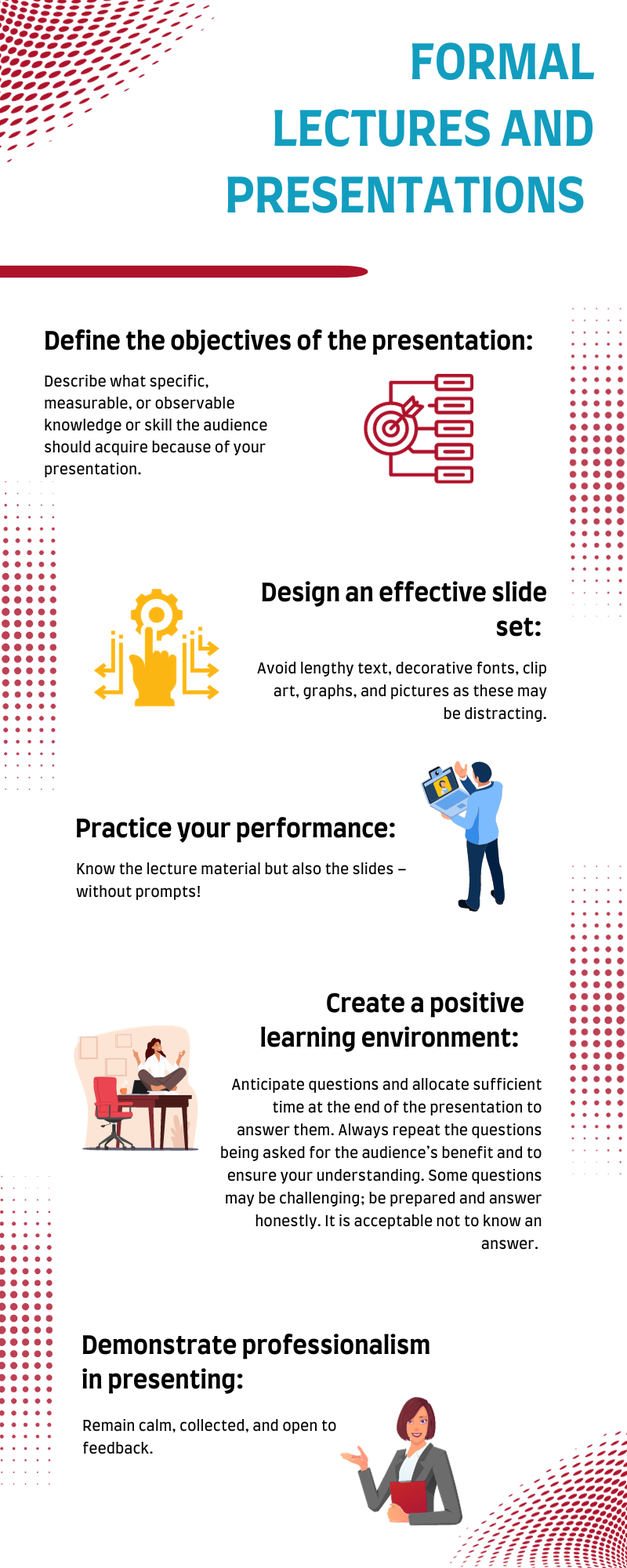
View long description of infographic .
Strategies for success
- Define the objectives of the presentation. Always define learning objectives for each of your lectures to make it clear what knowledge or skills the audience should acquire from your presentation. The best learning objectives define specific, measurable, or observable knowledge or skill gains. Furthermore, consider how to communicate the importance of the topic to your audience and how information should be arranged to best communicate your key points.
- Design an effective slide set. You should begin creating your slides only after defining your objectives and key points. The slides should support your talk but not be your talk. Keep slides simple. The audience should be able to review a slide and grasp key points quickly. Avoid lengthy text and distracting decorative fonts, clip art, graphs, and pictures. If additional wording or images are necessary, consider handouts or alternative methods of sharing this information. Lastly, design your slide deck to emphasize the key points, revisiting your outline as necessary, and summarize concepts at regular intervals throughout your presentation to strengthen knowledge gains.
- Practice your performance. Effective public speaking starts with preparation and practice. Ensure there is enough time to create your lecture and a supporting slide deck. Know your lecture material and slides without prompts! Understand the audience and learning climate (the size and knowledge level of your audience) and be prepared for the venue (virtual, in-person, or both, lecture hall or classroom). Think about what effective audience engagement may look like and how to incorporate audience response systems, polling, etc., into the lecture.
- Create a positive learning environment. Anticipate questions and allocate sufficient time to answer them. Always repeat the questions being asked for the audience’s benefit and to ensure your understanding. Some questions may be challenging, so be prepared and answer honestly. It is acceptable not to know an answer.
- Demonstrate professionalism in presenting. Exhibit professionalism by being punctual and having appropriate time management. Remember that mistakes happen; be kind to yourself and remain calm and collected. Be enthusiastic: If you can enjoy the experience, so will your audience. Finally, be open to feedback following your presentation.
Additional resources
Below is a collection of resources that further address the elements of creating and delivering a formal presentation. Each resource addresses a specific presentation skill or set of skills listed above and can be used to develop your understanding further.
- Healthy Presentations: How to Craft Exceptional Lectures in Medicine, the Health Professions, and the Biomedical Sciences (requires purchase, book). This illustrated book is a practical guide for improving scientific presentations. It includes specific, practical guidance on crafting a talk, tips on incorporating interactive elements to facilitate active learning, and before-and-after examples of improved slide design. (Skills addressed: 1-3)
- American College of Physicians: Giving the Podium Presentation (freely available, website). This guide includes recommendations related to presentation delivery, including tips on what to wear, how to prepare, answering questions, and anticipating the unexpected. (Skills addressed: 3-5)
- The 4 Ps of Giving a Good Presentation (freely available, PDF). This simple guide on public speaking from the University of Hull covers such topics as positive thinking, preparing, practice, and performing. (Skills addressed: 3-5)
- Zoom Guides (freely available, website). This website from the University of California, San Francisco is one of many great resources created by universities for presenting on a virtual platform, specifically Zoom. (Skills addressed: 3-5)
- Writing Learning Objectives (freely available, PDF). This excellent resource from the AAMC defines Bloom’s Taxonomy and provides verbiage for creating learning objectives. (Skill addressed: 1)
- Adult learning theories: Implications for learning and teaching in medical education: AMEE Guide No. 83 (freely available, article). This AMEE Guide explains and explores the more commonly used adult learning theories and how they can be used to enhance learning. It presents a model that combines many of the theories into a flow diagram that can be followed by those planning a presentation. (Skill addressed: 1)
- Assertion-Evidence Approach (freely available, website). This approach to slide design incorporates clear messaging and the strategic combination of text and images. (Skill addressed: 2)
- Multimedia Learning (requires purchase, book). This book outlines the learning theories that should guide all good slide design. It is an accessible resource that will help presenters of all levels create slide decks that best facilitate learning. (Skill addressed: 2)
- Collaborative Learning and Integrated Mentoring in the Biosciences (CLIMB) (freely available, website). This website from Northwestern University shares slide design tips for scientific presentations. Specific tips include simplifying messages and annotating images and tables to facilitate learning. (Skill addressed: 2)
- Clear and to the Point (freely available, online book). This book describes 8 psychological principles for constructing compelling PowerPoint presentations. (Skill addressed: 2)
Return to top ↑
Presenting the results of the research projects, innovations, and other work you have invested in at regional and national meetings is a tremendous opportunity to advance heath care, gain exposure to thought leaders in your field, and put your evidence-based medicine and communication skills into practice in a different arena. Effective scientific presentations at meetings also provide a chance for you to interact with an engaged audience, receive valuable feedback, be exposed to others’ projects, and expand your professional network. Preparation and practice are integral to getting the most out of these experiences.
The strategies and resources below will help you successfully present both posters and abstracts at scientific meetings.
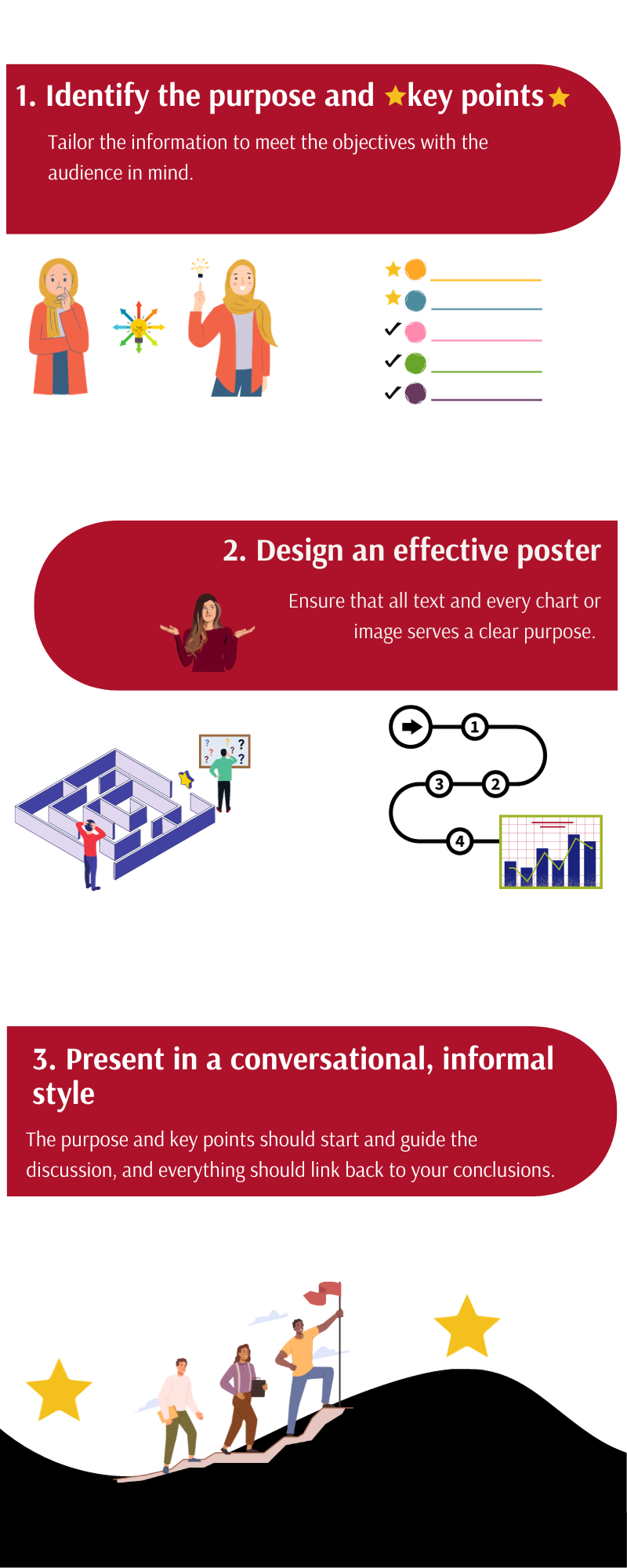
Strategies for success
- Identify a poster’s/abstract’s purpose and key points . Determine the purpose of sharing your work (feedback vs. sharing a new methodology vs. disseminating a novel finding) and tailor the information in your poster or abstract to meet that objective. Identify one to three key points. Keep in mind the knowledge and expertise of the intended audience; the amount of detail that you need to provide at a general vs. specialized meeting may vary.
- Design an effective poster . Design your poster to follow a logical flow and keep it uncluttered. The methods and data should support your conclusions without extraneous information; every chart or image should serve a purpose. Explicitly outline the key takeaways at the beginning or end.
- Present in a conversational, informal style . Imagine you are explaining your project to a colleague. The purpose of your work and key points should guide your presentation, and your explanation of the methods and data should link to your conclusions. Be prepared to discuss the limitations of your project, outline directions for future research, and receive feedback from your audience. Treat feedback as an opportunity to improve your project prior to producing a manuscript.
Additional resources
These resources support the development of the skills mentioned above, guiding you through the steps of developing a poster that frames your research in a clear and concise manner. The videos provide examples that can serve as models of effective poster and abstract presentations.
- How to design an outstanding poster (freely available, article). This article outlines key items for laying out an effective poster, structuring it with the audience in mind, practicing your presentation, and maximizing your work’s impact at meetings. (Skills addressed: 1-3)
- Giving an Effective Poster Presentation (freely available, video). This video shows medical students in action presenting their work and shares strategies for presenting your poster in a conversational style, preparing for questions, and engaging viewers. (Skills addressed: 2,3)
- Better Scientific Poster (freely available, toolkit). This toolkit includes strategies and templates for creating an effective and visually interesting scientific poster. Virtual and social media templates are also available. (Skill addressed: 2)
As with all presentations, it can be very helpful to practice with colleagues and/or mentors before the meeting. This will allow you to get feedback on your project, style, and poster design prior to sharing it with others outside of your institution. It can also help you prepare for the questions you may get from the audience.
Patient presentation skills are valuable for medical students in the classroom and in the care of patients during clinical rotations. Patient presentations are an integral part of medical training because they combine communication skills with knowledge of disease manifestations and therapeutic strategies in a clinical scenario. They are used during active learning in both the preclinical and clinical phases of education and as students advance in training and interact with diverse patients.
Below are strategies for delivering effective patient presentations.
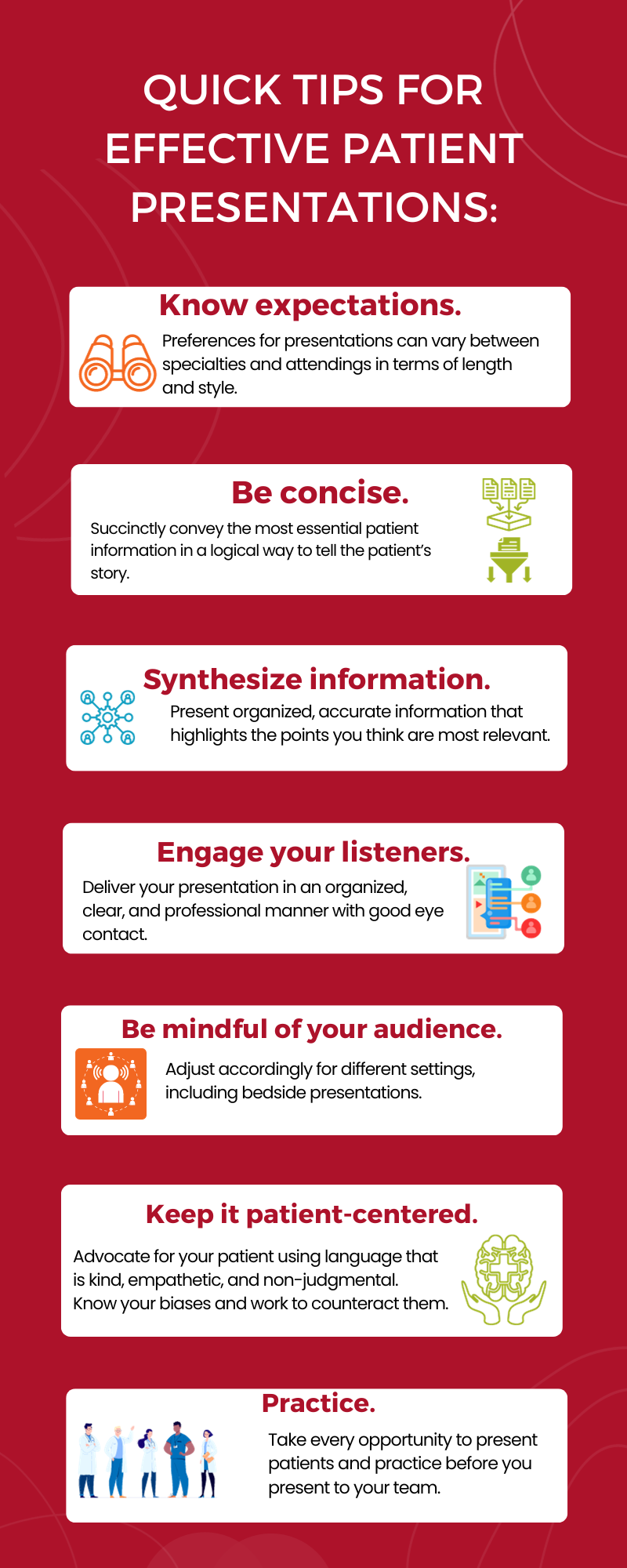
- Structure the presentation appropriately . The structure of your narrative is important; a concise, logical presentation of the relevant information will create the most impact. In the clinical setting, preferences for presentation length and style can vary between specialties and attendings, so understanding expectations is vital.
- Synthesize information from the patient encounter . Synthesis of information is integral for effective and accurate delivery that highlights relevant points. Being able to select pertinent information and present it in an efficient manner takes organization and practice, but it is a skill that can be learned.
- Deliver an accurate, engaging, and fluent oral presentation . In delivering a patient presentation, time is of the essence. The overall format for the presentation is like a written note but usually more concise. Succinctly convey the most essential patient information in a way that tells the patient’s story. Engage your listeners by delivering your presentation in an organized, clear, and professional manner with good eye contact. Presentations will go more smoothly with careful crafting and practice.
- Adjust presentations to meet team, patient, and setting needs . Adaptability is often required in the clinical setting depending on attending preferences, patient needs, and location, making it imperative that you are mindful of your audience.
The resources below provide samples of different types of patient presentations and practical guides for structuring and delivering them. They include tips and tricks for framing a case discussion to deliver a compelling story. Resources that help with adjusting patient presentations based on the setting, such as bedside and outpatient presentations, are also included.
- A Guide to Case Presentations (freely available, document). This practical guide from the Ohio State University discusses basic principles of presentations, differences between written and oral communication of patient information, organization, and common pitfalls to avoid. (Skills addressed: 1-3)
- Verbal Case Presentations: A Practical Guide for Medical Students (freely available, PDFs). This resource from the Augusta University/University of Georgia Medical Partnership provides a practical guide to crafting effective case presentations with an explanation of the goals of each section and additional tips for framing the oral discussion. It also provides a full sample initial history and physical examination presentation. (Skills addressed: 1-4)
- Patient Presentations in Emergency Medicine (freely available, video). This training video for medical students from the Society for Academic Emergency Medicine demonstrates how to tell a compelling story when presenting a patient’s case. The brief video offers handy dos and don'ts that will help medical students understand how best to communicate in the emergency department efficiently and effectively. These skills can also be applied to patient presentations in other specialties. (Skills addressed: 1-4)
Additional information and support on effectively constructing and delivering a case presentation can be found through various affinity support and mentorship groups, such as the Student National Medical Association (SNMA), Latino Medical Student Association (LMSA), and Building the Next Generation of Academic Physicians (BNGAP).
Leading Small Groups
For physicians, working within and leading small groups is an everyday practice. Undergraduate medical education often includes small group communication as well, in the form of problem-based learning groups, journal clubs, and study groups. Having the skills to form, maintain, and help small groups thrive is an important tool for medical students.
Below are strategies to provide effective small group leadership.
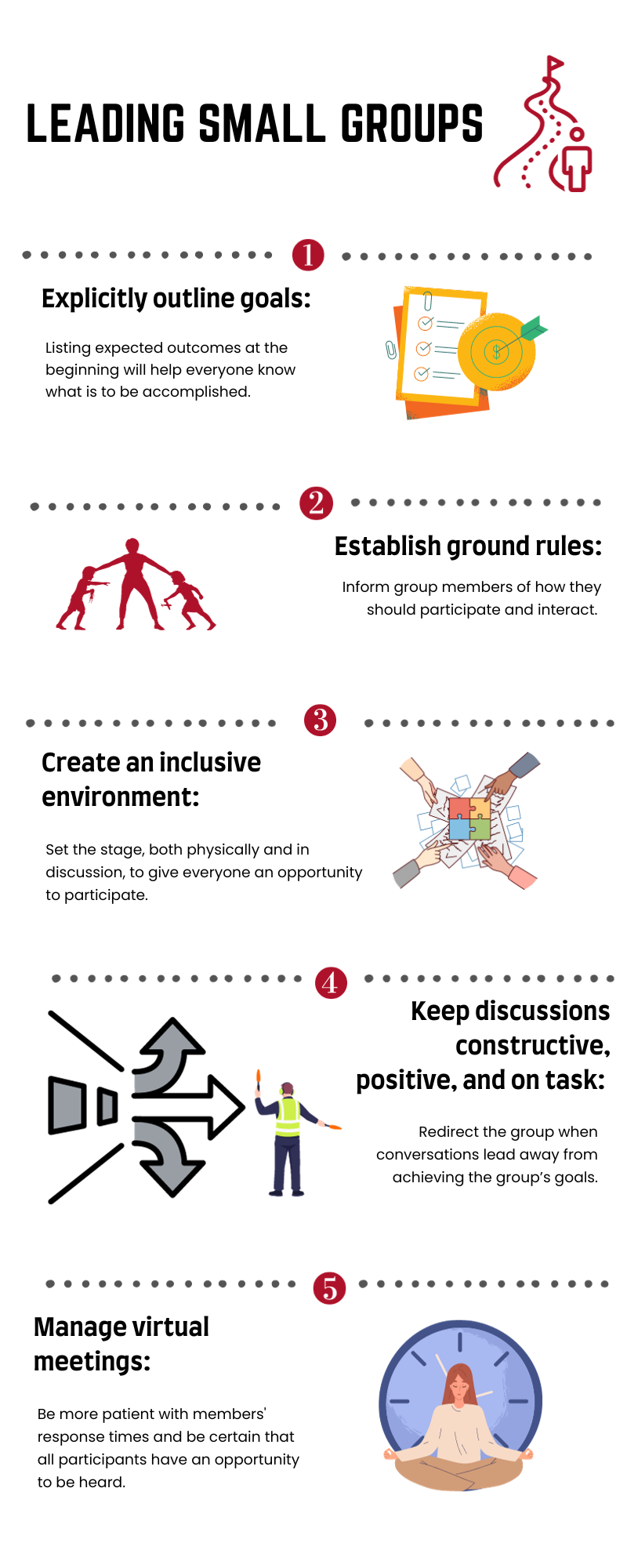
- Outline goals/outcomes . Delineating the goals of a meeting ensures that everyone understands the outcome of the gathering and can help keep conversations on track. Listing goals in the agenda will help all participants understand what is to be accomplished.
- Establish ground rules . Establishing explicit procedural and behavioral expectations serves to solidify the framework in which the conversation will take place. These include items such as attendance and how people are recognized as well as the way group members should treat each other.
- Create an inclusive environment . In addition to setting expectations, group leaders can take steps to help all participants feel that their perspectives are valuable. Setting up the room so that everyone sits around a table can facilitate conversations. Having individuals introduce themselves can let the group understand everyone’s background and expertise. In addition, running discussions in a “round-robin style” (when possible) may help every person have an opportunity to express themselves.
- Keep discussions constructive, positive, and on task . As meetings evolve, it can be easy for conversations to drift. Reminding the group of goals and frequently summarizing the discussion in the context of the planned outcomes can help redirect meetings when needed.
- Manage virtual meetings . Online meetings present their own challenges. Adequate preparation is key, particularly working through technological considerations in advance. Explicitly discussing goals and ground rules is even more important in the virtual environment. Group leaders should be more patient with members’ response times and be especially diligent that all participants have an opportunity to be heard.
The resources listed below outline additional helpful points, expanding on the skills described above and providing additional perspectives on managing small group meetings of different types.
- Communication in the Real World: Small Group Communication (freely available, online module). This chapter includes an overview of managing small groups, including understanding the types and characteristics, group development, and interpersonal dynamics. (Skills addressed: 3,4)
- Conversational Leadership (freely available, online book chapter). This short online resource provides guidance for determining group size and seating to best facilitate participation by all group members. (Skill addressed: 4)
- Tips on Facilitating Effective Group Discussion (freely available, PDF). This resource from Brown University provides tips for effective group facilitation, creating an environment conducive for discussions, keeping conversations positive, and managing common problems. Also included is a valuable list of references for further exploration. (Skills addressed: 1-4)
- Facilitating Effective Discussions: Self-Checklist (freely available, online checklist). This checklist from Brown University provides an easy-to-use, practical framework for preparing for, performing, and reflecting on small group facilitation. (Skills addressed: 1-4)
- Sample Guidelines for Classroom Discussion Agreements (freely available, PDF). These guidelines from Brown University give useful tips for managing classroom discussions, including when disagreements occur among group participants. (Skill addressed: 2)
- Fostering and assessing equitable classroom participation (freely available, online article). This online resource from Brown University includes methods to maximize group members’ participation in discussions and to communicate expectations. Also included is a valuable list of references for further exploration. (Skill addressed: 3)
- Facilitating small group learning in the health professions (freely available, online article). The aim of this paper published in BMC Medical Education is to provide students involved in peer/near peer teaching with an overview of practical approaches and tips to improve learner engagement when facilitating small groups. It includes a discussion of the roles of facilitators, strategies for fostering interactions among the group, and methods for resolving common problems. (Skills addressed: 1-4)
- Facilitating a Virtual Meeting (freely available, PDF). This infographic from the University of Nebraska Medical Center includes key points to consider when facilitating an online meeting, including technical considerations, preparation, and follow-up. (Skill addressed: 5)
- Most universities have a communication department with faculty who specialize in small group communication. You may also find that these individuals are a valuable resource.
This toolkit was created by a working group of the Undergraduate Medical Education (UME) Section of the Group on Educational Affairs (GEA).
Working Group Members
- Geoffrey Talmon, MD, University of Nebraska Medical Center
- Jason Kemnitz, EdD, University of South Dakota Sanford School of Medicine
- Lisa Coplit, MD, Frank H. Netter School of Medicine at Quinnipiac University
- Rikki Ovitsh, MD, SUNY Downstate College of Medicine
- Susan Nofziger, MD, Northeast Ohio Medical University
- Amy Moore, MEd, Cleveland Clinic Lerner College of Medicine
- Melissa Cellini, MD, New York Medical College
- Richard Haspel, MD, Harvard Medical School
- Christine Phillips, MD, Boston University School of Medicine
- Arvind Suresh, Geisel School of Medicine at Dartmouth
- Emily Green, PhD, MA, Warren Alpert Medical School of Brown University
- Holly Meyer, PhD, MS, Uniformed Services University of the Health Sciences
- Karina Clemmons, EdD, University of Arkansas for Medical Sciences
- Shane Puckett, EdD, University of South Florida
- Angela Hairrell, PhD, Burnett School of Medicine at Texas Christian University
- Arkene Levy Johnston, PhD, Kiran C. Patel College of Allopathic Medicine
- Sarah Collins, PhD, UT Southwestern Medical Center
- Patrick Fadden, MD, Virginia Commonwealth University School of Medicine
- Lia Bruner, MD, Augusta University - University of Georgia Medical Partnership
- Jasna Vuk, MD, PhD, University of Arkansas for Medical Sciences
- Pearl Sutter, University of Connecticut School of Medicine
- Kelly Park, Baylor University Medical Center
Medical Presentations: How to Present Effectively on Urgent Topics

In the face of the pandemic that consumed 2020, we saw an uptick in medical presentations. And rightfully so. The world was in a state of panic over the unknown of a new virus, people were craving information, and organizations like the World Health Organization (WHO) were scrambling to provide data and resources to help address questions and concerns. Whether it was news stories, or medical research, the world needed to understand what we were up against with COVID-19. Naturally, presentations helped to deliver that information. But this isn’t the first time a virus or disease has rattled communities, and it’s certainly not the first time professionals have used medical presentations to educate the masses. Medical presentations are a helpful tool for medical professionals, research clinics, and organizations to help inform and educate their communities on a wide variety of urgent topics. This can include patient treatment, clinical trial research and results, training for medical staff, general education, medical research, or important data regarding diseases.
While medical presentations tend to be fundamentally different from normal presentations in that they include critical and sensitive information, there are still design best practices just like any other deck. That said, what works for a sales pitch might not resonate well with a medical presentation.
Keep these five things in mind when you want to present effectively on urgent medical presentation topics.
Consider your audience
You may be presenting to a group of doctors within your organization to get the team up to speed on new practices, sharing treatment plans with a patient, or educating the community on new health threats. How you structure your medical presentation is not a one-size-fits-all situation. How you talk to internal staff, versus how you would deliver information to a scared patient is not the same. When you’re crafting your message, consider your audience, and tailor the narrative to their overarching concerns and needs.
Keep things straightforward
Unless you’re presenting to third year residents, your audience probably won’t be able to digest complicated medical terminology. It’s important to avoid medical jargon, complex definitions, or overcomplicated explanations that will confuse your audience. Instead, break things down in layman's terms and relate the information back to your audience and how it will affect them. Keeping things straightforward, and clear, will help your audience digest and process the information quicker. The end goal is that your audience leaves with clarity, feeling more educated on the topic and its urgency.
Use icons to reflect the urgency of the situation
The use of visual aids, such as compelling images or meaningful icons, can help paint the picture of urgency in any presentation. Things like clocks, alarms, lightning bolts, or exclamation points can depict emergencies and symbolize something significant in your presentation. The use of impactful visuals will help engage your audience and let them know what they absolutely need to pay attention to. It helps you control the narrative, and highlight any pertinent information or key takeaways.
Beautiful.ai’s free library of hundreds of thousands of images and icons can help take your presentation to the next level. Our custom icons were thoughtfully created by one of our in-house designers, and are a great way to compliment your data and add urgency to your slide .
Hit them with the facts
In most medical presentations, factual data carries the slides. Whether it’s a survey, research results, or statistics about a particular disease, numerical data will help people understand the urgency or severity of the topic. For example, it was common for nearly every COVID-19 presentation or article to include statistics of the percentage of the population infected, which regions were seeing the greatest spikes in cases, death tolls by county, and data relevant to high-risk individuals. While the numbers may not always be fun— especially as they pertain to a pandemic— they paint a clear picture of what the audience needs to understand. Seeing scary statistics can put into perspective just how real the situation is.
Using the proper charts, graphs , or infographics allows you to dictate exactly what information the audience is consuming. Data visualization with infographics can also help the audience understand and retain otherwise complicated data. However, even with the best charts, you can still overwhelm the audience with information. Opt to include only the most relevant info and useful data.
Allow time to process
Regardless of what you’re presenting— big or small— you should leave time at the end for questions. Medical presentations can be paralyzing, and your audience will likely be seeking more answers. Give your audience a minute or two following the presentation to process what they learned, and then give them a chance to ask questions. You may need to elaborate on specific slides, or revisit a piece of data, to help provide clarification. When it comes to urgent topics, you want your audience to leave feeling more knowledgeable and at ease than they were prior to tuning in.

Jordan Turner
Jordan is a Bay Area writer, social media manager, and content strategist.
Recommended Articles
Common pitfalls to avoid when creating a sales deck, sales pitch training: how to build pitch templates that will power up your junior sales team, the go-to checklist for prepping your online presentations, tips for effective business presentations in 2022.

- Tips & Tricks
- PowerPoint Templates
- Training Programs
- Free E-Courses
Ultimate Guide to Medical Presentations: Templates, Tutorials, Tips and Resources
About medical presentations.
Medical presentations are fundamentally different from other presentation types. In fact, they are one of the toughest type of presentations to design.
Medical slides have research facts, data charts, diagrams and illustrations that demand a totally different approach to design. You need a slide creation method that considers the unique problems you face as a medical presenter. In this guide, you will Tips, Tutorials and resources to get your started with making over your Medical slides.
We will start with some general tips and tricks on creating medical slides and then proceed to step by step tutorials.

Quick Navigation
Tips to create Medical Presentations
PowerPoint Tutorials for Medical Slides
How to Present Lists & Text
How To Showcase Pictures Creatively
How to use animations effectively, creative morph transition ideas, making medical slides easy to understand, powerpoint delivery tips, powerpoint tips & tricks, issue with typical medical slides, medical slides makeover examples, medical powerpoint templates, free medical & healthcare icons, free medical presentation images, more resources for medical presentations, tips to create medical presentations, how to avoid overwhelming audience in technical presentations.
Do you want to improve how you explain concepts in a technical presentation? In this article, you will find a powerful technique called ‘Telescopic explanation’ to make your technical presentations much clearer and more memorable for your audience. To know more, read this post over on PrezoTraining.com

Tips to present Scientific Information
There are two major facets to a presentation: the content and how you present it. Let’s face it, no matter how great the content, no one will get it if they stop paying attention.
Here are some pointers on how to create clear, concise content for scientific presentations – and how to deliver your message in a dynamic way. Find the tips over on Elsevier connect .
Preparing a Research Presentation
If you have never presented a paper at a scientific meeting, or would like to polish your research presentations, this post contains information that will improve your presentation.
This article contains a set of guides and checklists to help you in the preparation of your presentation. Read this post on ACP .
10 Tips for Medical Presentations
Whether you are presenting an audit or a case report at a local meeting, presenting a paper at a conference, presenting a business case to your Trust, or even presenting on a hot topic at your medical interview, you will need to know how to prepare medical slides which attract your audience rather than distract it. This post on ISC Medical provides 10 tips for Medical presentations.
For a 5-Part series on how to make your Medical Slides Clear and Visual , sign up for our Free E-course.
In the following sections, you'll find step by step PowerPoint tutorials & Makeover Ideas to help you makeover different parts of your presentation.
How To Present Lists and Text
Information presentations use a lot of text and bullet list. In this section, you will find some creative ways to design these type of slides.
PowerPoint Tip: How to Present Long Lists on One Slide
If you have a Long Lists of items on One Slide here is a one-click trick on how to do this. Watch the video below to know more.
PowerPoint Trick to Convert Text to Graphics
Find a useful PowerPoint SmartArt Trick to convert Bullet Point Text to Graphics quickly and easily. Learn how to take the graphics to the next level with some creative ideas from Ramgopal.
For a 5-Part series on how to make your Medical Slides Clear and Visual , sign up for our Free e-course.
Get access to exclusive members-only e-courses & downloads.
Medical presentations usually have a lot of pictures. Especially the training and informational slides. Here are some ways in which you can present the pictures in your presentations in a creative way.
Right Way to Showcase Pictures
Learn the benefit of showcasing pictures using SmartArt tool in PowerPoint. In the video below we start with a typical picture Showcase slide used by presenters. Though the slide looks quite attractive in the first glance, there are some issues that makes the slide ineffective. Watch the video below to know more:
Cropping Pictures in PowerPoint
Learn a super easy trick to crop a picture in PowerPoint in a step by step way. This trick will help you crop a picture in the shape you want, in a single click.
A PowerPoint slide with too much content can be overwhelming for the audience. If you learn to sequence the way you present your information, you make it easy for your audience to understand your presentation.
Here are different ways you can use Custom Animations and Morph Transition effects to sequence information.
Animation for Process with Pictures
In this tutorial, you will find how to create a useful and practical slide with pictures and text to show a process or a timeline diagram. Learn how to create and present it to make an impact.
Animation for Highlighting Pictures
Learn to create an Animated Picture Reveal Effect in PowerPoint. Present your important picture with this effect. Watch the video to preview the effect and learn how to create it:
Sequential Fading technique in PowerPoint
This trick is super useful for medical presentations where you need to present an image step by step. Since it is an image you cannot break it up and present it in parts. However with this useful technique you can highlight one part of an image at a time with animation.

For a 5-Part series on how to make your Medical Slides Clear and Visual , sign up for our Free e-course. Get access to exclusive members-only e-courses & downloads.
In PowerPoint for Office 365, Microsoft introduced the Morph Transition. It is an effective way to create animations fast. Here are some ideas on how you can use this feature to create your slides.
Pros & Cons with Morph Transition
Learn how to create an easy animated scales diagram with Morph Transition Effect. This effect is available in PowerPoint for Office 365. You can also sign up & download the original PowerPoint file over at our website .
Morph Transition To Present Pictures
In this video you will find how to use PowerPoint Morph Transition to replace Custom Animations. See how this can be done with this example of a slide with multiple pictures with text.
Convert your boring text-based slides, blog articles or research papers into clear & beautiful visual slides - even if you have zero Design skills, zero PowerPoint skills & very little time - using our ‘4-step Neuro Slide Design System for Medical Presentations’
Watch the video below to learn more:
Ideas to Present Data
Medical presentations also usually contain a component of data. This could be related to statistics or research. In this section, you will find some easy ways to makeover your slides with numbers.
Creating Pie & Donut Charts
Learn how to create a Pie chart in PowerPoint with this step by step tutorial. This video also covers how to adjust the Pie chart settings and also how to add Donut charts.
How to Animate a PowerPoint Table
Learn a trick to Animate a PowerPoint Table. PowerPoint does not have the feature of animating parts of a table.
[Advanced] Conditional Formatting for Charts
Learn to create a PowerPoint conditional formatting chart that changes color and direction of bar chart automatically for negative values. The positive values are displayed in green color and the negative values in red color.
Here are some tips for when you are actually delivering your presentation. Present confidently with these ideas!
Use Presenter View in PowerPoint like a PRO
How to use Presenter View in PowerPoint to present your slides like a PRO (Presentation Delivery Tips). This view is for the presenter only - when the slideshow This requires 2 monitors (your laptop and the projector screen). Even if you want to use Presenter View in 1 monitor it is possible. Learn how with this video.
Use Hidden Slides to Present Confidently
In this video, you will find a PowerPoint Tip on how to use Hidden slides to present confidently. This feature is especially useful when creating business presentations.
PowerPoint Slideshow Shortcuts
Here are some useful PowerPoint Slideshow Shortcuts you can use when delivering your next presentation. Hope you find these PowerPoint tips useful.
If you wish to improve the quality of your medical slides in a reliable way, take a look at the first video over on this page .
Here are some tips and tricks to reduce time taken to create your slides.
Setting Up Quick Access Toolbar
In this PowerPoint tips tutorial, you will find how to set up the Quick Access Toolbar. It is a great time-saving tool for any version of PowerPoint.
Autocorrect Trick to Save Time
Learn this trick to use PowerPoint Auto-correct option to save time and effort in creating your presentations. Write complex medical terminology accurately & easily in PowerPoint!
Get access to exclusive members-only e-courses & offers.
Many of the medical slides you may see may look like this:

These slides are taken from various sources online like Slideshare and YouTube and represent various types of presentations. The common issues with such slides include:
- Issue with readability - due to poor color choices and font sizes
- Unprofessional design - with overlapping content, hard to read diagrams etc.
- Too much content - that overwhelms the audience
It is quite common to see well researched medical content being totally ignored by the audience - because the presentation slides look busy and boring. And… You can’t blame your audience for tuning out of your presentation.
The quality of your slides makes or breaks your medical presentations.
In this section, we'll makeover usual text filled PowerPoint slides into a visual and interesting slides.
The original slides are taken from various sources online like Slideshare and YouTube and represent various types of presentations.
Medical Title Slide
Original title slide:

Title slide after makeover:

Medical Training Presentation Slide
Original training slide:

Training slide after makeover:

Medical Slide With Quote
Original slide with quote:

Quote slide after makeover:

Health and Safety Training Slide

Slide after makeover:

In the Medical Presentations Bundle with Neuro Slide Design Training, you can watch me make over Text-based slides, a Blog article, a Wikipedia article and a 11-page Research paper. I go through each of the 4 steps to transform these text-based documents to clear and beautiful visual slides.
The Bundle includes 900 Fully Editable PowerPoint Templates. Go over and checkout the bundle .
One of the ways to quickly improve the quality of your slides is to use good quality templates create with the needs of medical presenters in mind. Here are some resources...
Free Medical Title Templates
Leawo website provides free medical title templates for download. These templates are suitable for different type of medical presentations. You can preview and download them here .

FPPT website provides similar free title templates for use as well. You can find title templates related to medical and health fields over here on FPPT .

Premium Medical PowerPoint Templates
While free medical PowerPoint Templates are good enough for student or non-critical presentations, if you are consultant or specialist, you may prefer to use high-quality PowerPoint Templates.
Preview Medical PowerPoint Templates Bundle
Create Medical Slides You Feel Proud to Present Using the Breakthrough Slide Design System created using proven Brain research principles. You can preview templates from our Medical Templates Bundle below:
Browse more templates and know more about the Medical PowerPoint Templates Bundle here .
Icons are useful to represent ideas on slides. Here are some useful links for downloading Healthcare and Medical Icons online.
ICONFINDER : This website has a good collection of vector icons without too many ads or links to other websites.. You can search iconfinder by keyword and specifically look for free to use icons. You can also search by types of icons like glyphs, outline, flat, filled outline, 3D and more.
VECTEEZY : This website provides both free and premium icons. The license may require you to provide attribution to the author. There are lot of popups and ads, and the focus in on their premium icons.
POWERPOINT : If you are using Office 365, you can find a lot of free icons right in PowerPoint. There are icons for people, technology and electronics, communication, business, analytics, commerce, education, signs and symbols, arrows, medical and much more. You can edit the fill colors of these icons to customize them.
Make your own icons in PowerPoint
Make your slides look professional and visual with these icons. Icons make it easy for your audience to remember the information you are presenting. Learn the secret to finding icons for free right within PowerPoint.
300+ Editable Icons for PowerPoint

The Medical Presentations Bundle includes 300+ Medical Icons for PowerPoint. You can break these icons into individual components, mix and match them to create custom icons that meet your specific needs. As one of the doctors using this Bundle said, it is a “ ONE STOP SHOP” for every busy medical practitioner.
Medical presentations can be made more interesting and engaging by the addition of relevant images. If you are looking for high-quality free images, here are some suggestions:
FREEIMAGES.COM : Images on this website are free for use for personal and commercial purposes. You can find a range of generic medical and healthcare images here.

PICJUMBO.COM : This site provides free and interesting images for backgrounds.

WIKIPEDIA is a great source for free images and illustrations. However, there are a couple of things to keep in mind when you use images from Wikipedia.
1) Please check the copyright terms for each image. You may need to provide attribution as per their terms.
2) Images may be of different formats, sizes, color schemes and quality.
Here is a collection of images from Wikipedia related to Brain:

150+ Medical Illustrations | 170+ Medical Photos | 150+ Silhouettes

In the Medical Presentations Bundle we have already done the hard work of putting together a large collection of high quality Medical, Pharma and Science photos & editable illustrations to use in your presentations.
Remember, these are not the usual photos of smiling Doctors and pretty handshakes. These are practical medical photos you can use in your medical slides to illustrate your ideas. As one of the doctors using this Bundle said, it is a “ONE STOP SHOP” for every busy medical practitioner.
For a 5-Part series on how to make your Medical Slides Clear and Visual , sign up for our Free e-course. Get access to exclusive members-only e-courses & downloads.
PowerPoint Skills for Medical Professionals Learn the 14 essential PowerPoint techniques that every medical professional needs to know to design clear medical slides. This training is part of Medical Presentations Bundle .
Advanced PowerPoint Video Tutorials Enhance your presentations with these ideas. In this section you will find extensive video tutorials for 2D and 3D Diagrams, Models, Picture Effects, Animations and More… Click here to browse
Enter your text here...
Liked it? Share:
Get 25 Creative PowerPoint Ideas Mini Course & Members-only tips & offers. Sign up for free below:
Medical Presentation Templates
Elevate medical communication with Venngage's presentation templates, designed to effectively convey intricate concepts through informative content and clear visuals. Craft impactful medical presentations that cater to healthcare professionals, researchers, and educators, ensuring precise and engaging communication of complex medical information.
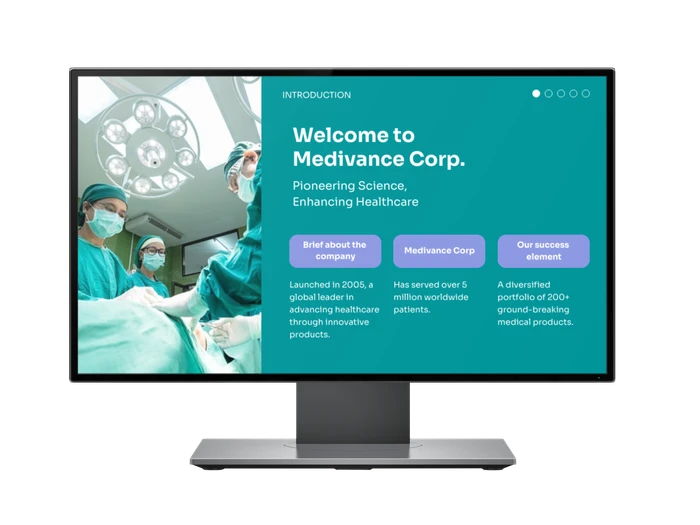
Other presentation templates
- Pitch decks
- User persona
- Brand guidelines
- Professional
- Group project
- Valentine's day
- Book report
- Mother's day
- Father's day
- Visual chart
- Architecture
- Social media
- Advertising
Popular template categories
- Infographics
- White papers
- Letterheads
- Newsletters
- Business cards
- Human resources
- Certificates
- Invitations
- Table of contents
- Magazine covers
- Price lists
- Album covers
- Book covers
- See All Templates
- Google Slides Presentation Design
- Pitch Deck Design
- Powerpoint Redesign
- Other Design Services

- Business Slides
- Guide & How to's
Make an impact with an engaging medical presentation
If you want to explain medical concepts or demonstrate a new medical invention, you’d better use medical presentations in PowerPoint. It allows you to make your slides modern & visually appealing with a few creative design moves. Suppose you need to illustrate a healthcare document or make a presentation on a medical topic. In that case, PowerPoint is good for organizing all points to mention, supporting your speech with images, and attracting people with great animation.
You can find plenty of medical presentation examples on the web to inspire or borrow some elements, e.g., icons, colors, themes, etc. If you lack time and skills, you can always address professional services and order medical or business presentation slides . It helps to devote more time to speech and full sleep.
Today, let us help you find out when to use, how to start, and what to add to create modern-looking healthcare PowerPoint visuals.

When to Use Medical PPT Presentation?
Initially, presentations are used to inform, educate or persuade different external and internal audiences. Medicine includes hard and simple explanations, so you can create a healthcare presentation for both children and scientists.
Using the power of words and correct animation, you can deliver the most complex concepts and explain to pupils how blood cells move. So, medical slide presentations are used for:
- Medical conferences;
- Medical cases;
- Medical training;
- Medical networking;
- Medical investment pitch;
- Medical services presentation;
- Medical TED talk;
- Medical university/college/school lecture;
- Medical invention demonstration.
We bet you can make up more situations where medical presentations fit, and we’ve collected the most common causes. Anytime you talk about healthcare problems or news, you need a medical presentation.
How to Start a Presentation on Healthcare?
Medicine topics refer to the section of hard ones, so PowerPoint presentations must be used wisely and correctly to make speech easier to understand. If you have to explain complex concepts, the presentation can be your life-saver if you approach it in a meaningful way.
Step 1: Rely on visuals
The first step is to look for visuals that can accompany your text. PowerPoint was created for animation, but many people incorrectly use slides for paragraphs of scientific information. Meanwhile, we grasp visual information 60,000 times faster than written one.
So, whenever you present technical information, your audience would want relevant visuals to support their understanding. Do not name types of bone fractures or blood cells, show them!
Step 2: Crop and enlarge your images
The next step is the extension of the first one. We recommend using one picture per slide and enlarging it if it contains tiny elements. For example, you want to show a cataract, so increase the image in size for all people to see clearly. Do not be afraid to sacrifice text for the big high-quality picture.
Step 3: Use charts to visualize numbers
Please, forget about bullet points and endless lists on slides. Pity your audience.
- Decide how many numbers or statistics you have to add as separate slides.
- Do not mix pictures with charts or graphs.
- Make them simple but clear.
- Use contrasting backgrounds and comment on every figure.
See, bullet points are only good in articles to make some space and differentiation in a long text.
Step 4: Make your graphics look more professional
Google for medical presentation video tutorials or address custom presentation services to improve PowerPoint presentation . If you need to present in front of professionals, they will most likely have expectations. Thus, use high-resolution images, position every element accordingly, match sizes of arrows/lines within one slide, and just remove all alien elements that clog the animation.

8 Simple Tips to Improve Your Healthcare PowerPoint Presentation
Even though the following tips are simple and easy to implement, they will have a significant impact on your medical slides.
Think ‘Non-Linear’
If you have to explain some definitions, do not present them in a boring linear way. It can easily disengage the audience from the slide. Instead, create an animated explanation with arrows: make the main word big in the middle of the slide and ‘draw’ around it. Why use only words if you work with PowerPoint?
Use simple animated visuals to explain concepts
For example, you have to explain how molecules move in the electric field. A sheet of hard-to-understand text does not attract the audience at all. To engage people better, draw how charged molecules move forward and back. Besides, add an oral explanation for people to visualize better. Thus, the information sticks to the audience’s brains and keeps them involved till the presentation ends.
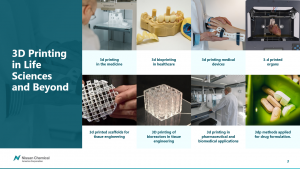
This slide does not just give a list of 3D printing examples but shows its real usage, which helps the audience visualize the information.
Label your images right
Images are an integral part of any medical presentation, but some presenters misuse them and create eye hops. It means the number of places the eyes have to land on a slide to gather information. When you create a presentation, THINK ABOUT THE AUDIENCE. Try to imagine how their eyes walk through the slide and make this path as convenient as possible.
For example, when you label throat parts, do not create a 1-5 list next to the picture. It may get people tired to walk from the list back to the image and again to the list. It is better to avoid numbers and label parts with names immediately.
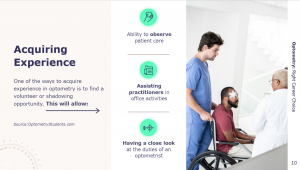
Here is a great example of a visually attractive and informative slide. The author has exactly thought about the people because he helped them perceive the information step by step.
Use tables for comparison
Bullet points are good, but slide space is limited, so you’d better use it wisely. Even if you apply custom animation using bullet points, you still present in a linear way. Accordingly, we advise you to use the table to compare two items with a column that defines the characteristics you oppose. It helps the audience of different levels to follow your thoughts. If people do not understand, they distract faster. So, do not let them do it.
Pay attention to information clarity
Make sure the images you place on the slide match with headlines or other marks. Sometimes, people are afraid of many slides and try to put images and text into one. And they disregard the fact that the audience in the back seats sees nothing.
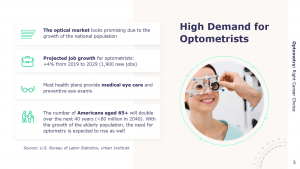
For example, this slide is good and informative, but the text might not be visible for the last lines.
Use charts to present numbers
For example, you want to list etiological factors for a specific disease. Instead of simply saying percentages, show them! People perceive and remember visual information better, so use charts to show the share of each factor. PowerPoint is created for animations, so always look for ways to avoid many words.
Lead with appropriate visuals
We highly do not recommend using photos of wounds, skin/organ diseases, or other body health problems. It may avert some people because these pictures aren’t indeed attractive. Instead, use drawn pictures, e.g., do not show SSI classification on real skin but use cross-section (like the one used in medicine books).
Avoid Using Photos as Slide Backgrounds
Strangely, many medical presenters still use photos for background for some unknown to us purposes. On the contrary, we suppose it is extremely hard for the audience to differentiate the main image or words from the background clog. Background photos do not bring you much value, but people perceive things better on a pure basis. So, please, stop using this habit. The simpler, the better!
Eye-catching animation has never spoiled anyone’s medical presentation. By adding suitable colors and pictures for a neat look, you demonstrate your expertise and support your speech. You will no more get lost if someone interrupts you. Complex topics are better explained with attractive visuals because all people perceive information better if accompanied by images. Therefore, you should use this preference to fit the audience of any size, age, and gender. Master medical presentations in PowerPoint and enjoy people’s attention!
#ezw_tco-2 .ez-toc-widget-container ul.ez-toc-list li.active::before { background-color: #ededed; } Table of contents
- Presenting techniques
- 50 tips on how to improve PowerPoint presentations in 2022-2023 [Updated]
- Keynote VS PowerPoint
- Types of presentations
- Present financial information visually in PowerPoint to drive results

The importance of visual storytelling in presentations (+ effective tips to consider)

- Design Tips
Why presentation of data is important?

8 rules of effective presentation
30+ Best Medical Presentation Templates
Communicate health information clearly with our medical presentation templates. These tools provide a range of clean, easy-to-read designs that can help you present medical information in an effective, professional way.

Modern Medical PowerPoint Template
This PowerPoint template comes with 30 unique slides featuring clean and modern designs. It also lets you choose from 5 different premade color scheme...

Medical Minimal Medicine PowerPoint Template
Another modern PowerPoint template featuring a medicine related theme. This template comes with a set of 50 unique slides that allows you to design ef...

Mednamic Medical Presentation PowerPoint Template
This is one of the best medical PowerPoint templates you’ll find on our list. It features a modern and clean design that offers many different s...

Medical PowerPoint Template
A modern PowerPoint template for medical presentations that comes with 63 unique slide designs. The template includes many editable vector graphics, i...

Medic Medical PowerPoint Presentation Template
If you’re looking for a medical PowerPoint template with a modern and creative design, this template is for you. It features 60 beautifully desi...

Medical & Health Infographic PowerPoint Template
If you use lots of infographics, timelines, charts, and graphs in your presentations, this PowerPoint template will come in handy. It includes 20 edit...
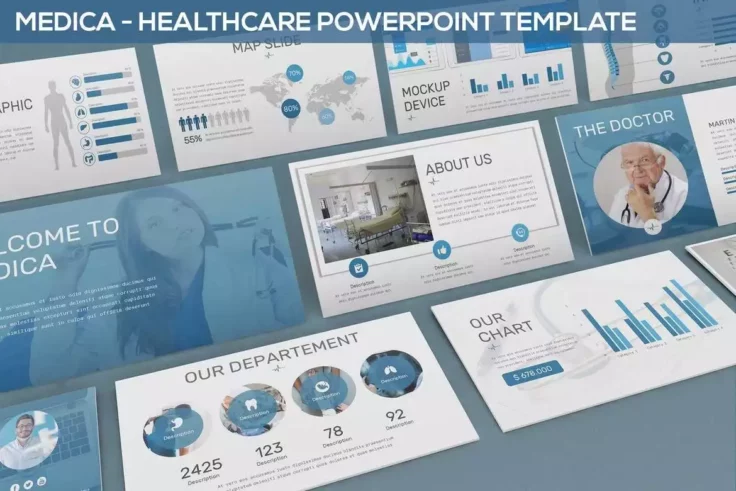
Medica Healthcare PowerPoint Template
Medica is a creative PowerPoint template featuring 30 unique slides in 3 different color schemes. The slides in this template are fully customizable a...

Healthcare & Medicine PowerPoint Template
This is a simple and modern PowerPoint template featuring 25 unique slides. The template comes in 3 different color schemes: Teal, Blue, and Green. It...

Medicine Healthcare PowerPoint Template
This bright and colorful PowerPoint template lets you customize and use 30 unique slides however you like to make powerful presentations that captivat...

MultiMedical Presentation Template
Multimedical PowerPoint template features many useful slide designs, including timelines, graphs, infographics, charts, diagrams, and much more. The t...

Medical Showcase PowerPoint Template
Medical Showcase is a modern and stylish PowerPoint template designed for making slideshows for medical-related events, conference, and all other pres...

Medical and Healthcare PowerPoint Template
If you’re working on a presentation for a hospital, medical center, or a healthcare related business, this PowerPoint template will come in hand...

MediCare Medical PowerPoint Template
Medicare is a modern PowerPoint template that features a minimalist design. It also includes slides filled with lots of graphs, charts, and infographi...

Prescription Medical PowerPoint Template
This PowerPoint template is perfect for designing presentations that highlight your key medical programs and services. It comes with a creative pink c...

Medika PowerPoint Template
Medika is a modern and creative PowerPoint template you can use to make slideshows for medical business and branding presentations. The template comes...

Glade Presentation Template
Glade is a modern PowerPoint template featuring a minimal slide design. The clean and creative content layout of each slide in this template will allo...

Medical and Hospital PowerPoint Template
An elegant PowerPoint template you can use to design a slideshow for a hospital, medical center, or a service based business for showcasing your compa...

MediLab Medical PowerPoint Template
Medilab comes with a simple and clean design. This PowerPoint template is perfect for making slideshows for medical conferences, startup events, and m...

Medicine Health PowerPoint Template
This minimal PowerPoint template features a simple slide design filled with creative illustrations, image placeholders, charts, and a content design m...

Therapeutics Presentation Template
This media PowerPoint template uses a clean and minimal slide design to effectively highlight your key points across the entire presentation. It lets ...
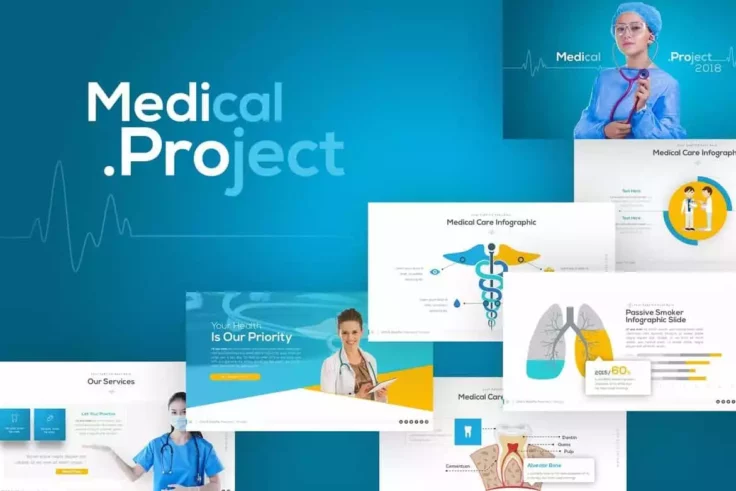
Medipro Medical Presentation Template
Medipro PowerPoint template features lots of modern elements that make it a unique template for designing presentations for modern startups and busine...

Medical Multipurpose PowerPoint Template
This is a multipurpose PowerPoint template that comes with 20 unique slides that can be easily customized to make many different types of healthcare t...

Eye Health PowerPoint Template
This PowerPoint template is specifically designed for making presentations related to optical and vision care. It features plenty of slides filled wit...

Medication Modern Medical PowerPoint Template
You can use this PowerPoint template to create modern presentations for medical treatment programs, medical services, and more. There are over 35 diff...

Medical Presentation PowerPoint Template
This is a multipurpose PowerPoint template featuring more than 100 unique slide designs. Using this template, you’ll be able to craft all kinds ...

Dentosta Dentist PowerPoint Template
Dentosta is a PowerPoint template made specifically for businesses and services related to dentistry. The template is available in 3 premade color sch...

Demedic Medical PowerPoint Template
Demedic is a modern PowerPoint template that comes with 30 unique slides. With this template, you get to choose from 3 different color schemes to desi...

Cure Healthcare PowerPoint Template
Cure is a simple and elegant PowerPoint template that features a modern design with a minimal clean layout. The template lets you choose from 30 uniqu...

Recoper Medical & Healthcare Powerpoint Template
Recoper is a modern PowerPoint template made with the medical and healthcare sectors in mind. It includes 40 different slide layouts that you can cust...

Medical Creative PowerPoint Presentation Template
This PowerPoint template comes with a set of slides filled with colorful designs, illustrations, and editable vectors. The template is also fully anim...

Antibiotics Medical PowerPoint Template
This template comes with a modern slide design that instantly attracts attention. It allows you to make bold presentations with slides filled with cre...

Medicalica Medical Business PowerPoint Template
A modern and professional-looking presentation template for making all kinds of medical presentations. This template includes 25 unique slides with pr...
FAQs About Medical Presentation Templates
What are medical presentation templates.
Medical Presentation Templates are pre-designed, professional slide decks that are specifically created for use in the healthcare and medical field. These templates can have a variety of themes, ranging from specific medical specialties like cardiology or dermatology, to broader themes like healthcare management or medical research.
These templates typically feature healthcare-related graphics, images, charts and diagrams, to help you visually communicate complex medical information. These templates are designed to save time and effort, while providing a professional and polished look to your presentations.
Where can you download Medical Presentation Templates?
You can download Medical Presentation Templates from a variety of online platforms specializing in digital resources and graphics. Some popular sites include, TemplateMonster, GraphicRiver, SlideModel, and Creative Market. These websites offer a wide selection of professional templates designed by experts in the field.
Before downloading a template, always check whether it aligns with your presentation's theme and objectives. Most sites offer previews of the individual slides contained in the template, allowing you to make an informed choice.
Are Medical Presentation Templates customizable?
Yes, Medical Presentation Templates are highly customizable. They are designed to function as a flexible starting point, allowing users to easily modify elements like colors, fonts, images, graphics, charts and other design components. These customizable features allow you to tailor the template to match your specific needs and style preferences.
Furthermore, users can add, delete, or rearrange slides, as well add their own content or text, to better suit the specific information they want to communicate in their presentation. However, the level of customizability can vary depending on the platform you have downloaded the template from, and the specific template design.
What software do you need to use Medical Presentation Templates?
The type of software you need to use Medical Presentation Templates typically depends on the format of the downloaded file. The most common formats are for Microsoft PowerPoint, Google Slides, or Apple’s Keynote. These are widely used presentation software and are generally compatible with most machines and operating systems.
Some medical templates might also be compatible with more specialized design software like Adobe Illustrator or Photoshop. Always ensure to check the specifications of the template to know what software or application you will need to edit and present it.
Why should I use Medical Presentation Templates?
Using Medical Presentation Templates can lend a high level of professionalism and visual appeal to your presentation. These templates are designed by experts and come with visually appealing graphics and charts that can enhance your audience's understanding of complex medical topics. They also save significant time and effort, freeing you from the task of creating a presentation layout from scratch.
Moreover, these templates can be tailored to fit different themes and formats, making them versatile for various presentation needs. Whether you're presenting a medical research finding, discussing a case study, conducting a training session, or speaking at a healthcare conference, there's likely a suitable medical Presentation Template for you.
My Speech Class
Public Speaking Tips & Speech Topics
89 Medical Speech Topic Ideas [Persuasive, Informative, Nursing]

Jim Peterson has over 20 years experience on speech writing. He wrote over 300 free speech topic ideas and how-to guides for any kind of public speaking and speech writing assignments at My Speech Class.
Medical speech topic list with public speaking ideas for an informative or persuasive medical text such as speech recognition software, Staphylococcus aureus or self-esteem problems. I have these informative ideas for a public speaking speech in mind for you:
In this article:
Informative
- Safety and legal issues on acupuncture.
- Frustrations for color blind people.
- The benefits of ozone therapy.
- What is Reiki stress reduction and relaxation?
- Tip for making up a first aid kit for wilderness expeditions.
- What is autism?
- Epidemiological studies on the bird flu.
- Which home tests are safe and reliable?
- Facts and myths about Cellulitis.
- Short-sightedness and long-sightedness explained.
- Medical speech recognition software developments.
- Heart attack signs.
- What health problems with diabetes, how to deal with them?
- Diagnosing a food allergy, symptoms, diagnosis, and treatment.
- How to prevent Lyme disease, spread to humans by infected ticks.
- A day with the crew of an air ambulance helicopter.
- Arguments for embryonic stem cell research.
- How to patent medicine.
- Philosophies about genetic engineering.
- Stages of pregnancy month by month.
- The importance of organ donation.
- The principles of medical ethics.
- What do our kidneys do?
Here are some concrete persuasive medical speech topic samples. Keep going back and forth in your mind to sort out the way you like to talk about it.
- Isolation is the best way to prevent the spread of Methicillin-resistant Staphylococcus aureus MRSA infections.
- Medical marijuana must be allowed for ill people – or not.
- Migraine often is misunderstood in the workplace.
- Most infertile couples use alternative medicine .
- Mental health issues affect us all in some way.
- Food allergy can manifest in behavior issues.
- Stuttering causes self-acceptance and self-esteem problems.
- The food industry should be blamed for obesity.
- Tourette’s syndrome patients can’t help it, let’s help them.
- Alzheimer’s disease should be involved in the care he or she will get.
- Atkins isn’t a quick fix for weight loss.
- Solve asthma by improving air quality.
- Effective medicines aren’t always expensive.
- Medical speech recognition and pathology experiences.
- Stopping smoking speeds recovery after operations.
- How a donation help your local Alzheimer’s charity.
- Everyone should donate blood.
- A woman can be too old to give birth.
- Air ambulance helicopters are the most efficient way to help victims of road accidents.
- Back pain is caused by a spinal disk problem.
- Beauty is not a valid reason to pursue cosmetic plastic surgery.
- Brushing your teeth twice a day will not keep the dentist away.
- Cell phones have a dangerous amount of radiation.
- Children should be first on organ transplant lists.
- Computer use is the reason for those repetitive strain injuries.
- Do not be afraid of biotechnology developments.
- Everyone needs dentistry insurance.
- Everybody should be an organ donor.
- Food allergy is a disease.
- Human fetal tissue research will help patients suffering from Alzheimer disease.
- Medication for general use should not be protected for 20 years.
- Needle exchange programs help to prevent the widespread of blood-borne viruses.
- Newborns without brains should not be used as organ donors.
- Nutrition patterns will change the human DNA genome structure.
- Patients should never accept money from the pharmaceutical industry.
- Pharmaceuticals are not transparent.
- Techniques and methods for transgenderation need to be assessed better.
- Terminally ill patients should freely rely on a hospital hospice program.
- The birth control pill is not safe.
- The E Coli bacteria is not explained properly enough.
- The morning-after pill must be freely prescribed in drugstores and pharmacies.
- The Morning-After Pill must be made available without a prescription.
- Using a known sperm donor is too risky.
- War veterans suffering from post-traumatic stress are not treated in time.
Of course these statements for a medical speech are not my opinion, but examples to trigger your mind for finding your own medical speech topic. Let these ideas form a rough outline in your head.
In other articles and entirely new threads I have written detailed tips to convert them into a real public speaking presentation.
Tip: A good topic title is short and sharp, conveys and channels a clear message, is easy to remember for the listeners, has no like or equal, is descriptive, and contains your own personal speaking signature.
Can We Write Your Speech?
Get your audience blown away with help from a professional speechwriter. Free proofreading and copy-editing included.
6 Additional Medical Persuasive Speech Topic Ideas
Medical persuasive speech topic ideas based on official position statements of organizations in the field, they are perfect for building speech topics in public speaking education. I scraped the net and found mission and vision claims that could be transformed into an issue for speechwriting purposes:
Sun Damage – ‘In most situations, sun protection to prevent skin cancer and sun damage to the skin is required during times when the ultraviolet index (UVI)A is raised’. According to the dermatology resource DermNet NZ. Offer pros and cons, and offer tips for listeners.
Dentistry – ‘The ADA Council on Scientific Affairs continues to believe that amalgam is a valuable, viable and safe choice for dental patients.’ Do you agree with the ADA Council on Scientific Affairs? Or not? Try to find persuasive arguments to adstruct the opposite, or weaken this firm medical persuasive speech topic ideas a little bit.
Nutrition – ‘In overweight and obese insulin-resistant individuals, modest weight loss has been shown to improve insulin resistance. Thus, weight loss is recommended for all such individuals who have or are at risk for diabetes.’ The American Diabetes Association writes on its site. Examine and prove direct relations between overweight and diabetes in a persuasion way of talking. Weight loss and diabetes in itself are great medical persuasive speech topic ideas.
Revalidation – ‘In the United Kingdom doctors will need to be revalidated every five years in order to retain their licence to practise.’ A citation of the Royal College of Surgeons of England. Good idea? Take a stand and convince your audience.
Equity – ‘A greater equity in health should be a progress indicator of populations within and between countries.’ That’s a formal statement of WHO World Health Organization. Do yo agree? Construct the arguments of this thesis.
Surgery – ‘Pregnant women should be given the right to choose major abdominal surgery (cesarean section) or a normal birth.’ That is the opinion of the American College of Obstetricians and Gynecologists. Judge pros and cons, convince your public as speaker in all ways. Good idea for an essay too!
Speech topics related to nursing, mental and travel health careh, and dietary counseling on primary care fostering for high school.
Many, especially female students, like to choose to prepare informative public speaking on an assistant to doctors related issue.
Here are twenty sample speech ideas, divided in specific central ideas and more general writing topics.
- How to help patients with self-care products.
- Medical treatment is not available to most people in the world.
- Involve a nurse in developing mental health policies.
- What community nurses can do for the health of the neigbourhood.
- Nursing is also an important provider of mental treatment in complex situations.
- Care in humanitarian disaster areas.
- Alzheimers and family relations.
- Travel health care services.
- The rights of mentally ill persons.
- Adolescents with disorders of development.
- Disabled children and their special needs.
- Neonatal care for premature babies.
- Benefits of nursery to the health system.
- Pediatric oncology for children with cancer.
- Dietary counseling for babies and their mothers.
- The altering role of male nurses in the past decades.
- What does the American Academy of Nurse Practitioners do
- The romantic history of Florence Nightingale.
- What education is needed to work in the healthcare business
- Medical ethics explained.
- The road to becoming a nurse.
- Please move your patients the right way!
66 Military Speech Topics [Persuasive, Informative]
259 Interesting Speech Topics [Examples + Outlines]
1 thought on “89 Medical Speech Topic Ideas [Persuasive, Informative, Nursing]”
You could include a topic on Fibromyalgia chronic disease.
Leave a Comment
I accept the Privacy Policy
Reach out to us for sponsorship opportunities
Vivamus integer non suscipit taciti mus etiam at primis tempor sagittis euismod libero facilisi.
© 2024 My Speech Class

How to Give an Excellent Medical Presentation
- By Sulaiman Ahmad
- July 22, 2019
- Medical Student , Pre-med
- Self-improvement
In medicine, we are constantly learning from each other. Professors stand in front of lecture halls to teach the fundamental knowledge needed to pass board exams and to treat our patients. Outside of the classroom, medical students, researchers, and physicians attend conferences to communicate ideas and update their colleagues with oral and poster presentations. In the clinic, students and resident physicians relay pertinent patient information to the physician in charge. Eventually, you will find yourself in front of an audience listening to your talk or an attending grading your clinical presentation. First, I will discuss what it takes to make an excellent presentation. I will then finish this topic by providing guidelines for perfecting different types of presentations.
Critical Elements of an Excellent Presentation
do some research.
Your audience will consider you an expert on the information you deliver. It is your job to achieve the expected level of comprehension of the topic. After choosing a topic, gather enough background information from diverse but appropriate sources (e.g., journals articles, relevant chapters in textbooks, personal discussion with subject matter experts, online videos). Your research should provide you with a thorough understanding of the topic and a list of the important facts supporting your take-home message . Any gaps in your knowledge will become evident during your presentation. The goal is to develop confidence in your understanding of the topic and ability to share what you know.
Know Your Audience
Before putting your presentation together, take a moment to assess the baseline understanding of your expected audience . Ultimately your audience should walk away having learned something new. Try to figure out their collective interest, reasons for attending, and prior experience with the topic. Knowing your audience will allow you to focus on information that will keep them engaged and interested. For example, premed students have a different understanding of medical topics than medical students. A presentation on the same subject should be different for both groups. If your listeners have different levels of expertise, take a moment to explain the fundamental concept, then build up the language and complexity to allow everyone to benefit from the information shared. Your audience is the reason why you are presenting.
Tell a Story
The human brain is wired to remember stories , especially if presented logically. A presentation is about the information shared, but it should also include the presenters’ passion, excitement, and personal style. All topics can be formatted to include characters, a description of the setting, plot, conflict, and a resolution. The story should allow the audience to take a journey with you. The hardest part is identifying the start and endpoint of your story and which details are needed. Make every word count by checking if it adds value to your narrative. Consider using metaphors, real examples, and descriptions that give life to your words .
Practicing your presentation is a vital step in developing an excellent presentation. You can memorize a script. However, memorization can reduce your connection with the audience. But in certain situations, scripts are quick and effective means of communicating important facts. Another approach is drafting bullet points of the main ideas and practicing the natural flow of information . This method allows your personality to shine on stage. To become comfortable speaking, start by practicing on your own . You can also record yourself with a cellphone or tablet and review the recording to evaluate your performance. Next, find a small group to present in front of and ask for their honest assessment . Eventually, your presentation will feel natural, and your stage presence will aid in communicating your main idea.
Q&A Session
Usually, your presentation does not end until after a question and answer session. Most presentations should include approximately five minutes in the end for the audience to ask questions . This part of the presentation allows you to clarify or further explain any part of your presentation. A question can also lead to expanding your presentation beyond what you originally planned to discuss . It is important for you to understand what is being asked and address the specific question directly. And if you do not have an answer, it is okay to admit that you do not know . Questions will force you to be creative and truly test your knowledge of the topic.

Different Types of Presentations
Presentations have many different forms, each with different goals; thus, each form requires a unique approach. In medicine, professors and clinician often provide students with lecture objectives and PowerPoint presentations that guide the students in their hour-long lecture. Conferences are a researcher’s platform to share their lab’s progress and conclusions. The last presentation I will go into is the clinical presentation a student typically performs for the physician in charge.
The main purpose of the lecture is to educate the attendees. We all have had great professors captivate our attention and other experiences that were a complete waste of time. But what makes some lectures better than others? The lecturer’s knowledge on the topic becomes obvious, and their stage presence confirms how comfortable they are with the topic. If you are tasked with lecturing on a topic or a series, ensure that you have a solid understanding and address your learning objectives in the time allotted . The main concepts should be repeated multiple times throughout the lecture, followed by examples . Your PowerPoint slides should be limited to only main points and images that support your talking points. After difficult concepts are covered, ask questions to gauge your audience’s understanding . It is better to reemphasize a concept before building up to more complex learning objectives.
Research Presentation
Attending a conference is exciting, especially if you are representing your lab with an oral presentation. It is an opportunity to share your research story, from the point of identifying a question to the process of reaching a conclusion. Realize your audience will include Primary Investigators, post-docs, and Ph.D. students that are also experts in the field . Attempt to grab the audience’s attention from the beginning by providing them with a reason to care. Then continue to explain how your study relates to the published work . After building up the background, address how you arrived at your research question. The most exciting part of your presentation should be explaining your conclusions and the path you took to get there. Finish up strong by discussing the implications of your findings and how they will have an impact in the field . The natural flow of information will come with practice and a deep understanding of your research topic. Presenting as a student usually leads to networking with professors and clinicians that can help you progress in your career.
Patient Presentation
Medical students learn how to take a patient’s history and perform a physical exam, but it is more challenging to reason through your clinical findings and subsequently present to an attending . Your clinical presentation style will change depending on the environment, medical department, and supervising physician . Upon joining a medical team, discuss the expectations and preference with each physician . It may be a good idea to draft a script that can get you started on organizing your patient presentation. The success of your presentation is correlated to your knowledge of the basic sciences and ability to critically assess the patient’s history and physical exam; the more you learn and read, the easier decision making and producing a plan becomes. Another important element is practicing your presentation style until it comes out naturally . Take the time to listen to your peers and experienced colleagues; learn from their mistakes and strengths . After concluding your presentation, ask for feedback and practice implementing the suggestions. You will be the eyes and ears for the physicians in charge, perfecting your patient presentation will help get the care the patients need while making everyone’s job a little easier.
Final remarks
There are some basic steps to achieving an excellent presentation: know the topic well, understand who you’re presenting to, develop a memorable story, and practice until it comes out naturally. A career in medicine is very versatile; you can be at the forefront of the next generation of physicians sharing your experiences or updating the science community with your research conclusions. At the minimum, you will be presenting the patient in the clinic. Thus, presenting is a skill every physician must master.
Sulaiman Ahmad

Anatomy of a Successful Medical Student — 5 Critical Traits
Those who thrive in med school—landing in top residency programs without costing their wellbeing—are different from the pack. This is how they do it.

6 Lifestyle Factors That Are Killing Your Focus
Successful students take a holistic approach to their studying and lifestyle. Here are 6 simple tactics that will help you develop laser focus.

The Anatomy of a Successful Premed — 5 Traits That Will Set You Apart
Success as a premed isn’t about being the smartest student in the room. These are the premed traits that will take you from zero to hero.
Leave a Reply Cancel reply

Join the Insider Newsletter
Receive regular exclusive MSI content, news, and updates! No spam. One-click unsubscribe.
Customer Note Premed Preclinical Med Student Clinical Med Student
You have Successfully Subscribed!
Got any suggestions?
We want to hear from you! Send us a message and help improve Slidesgo
Top searches
Trending searches
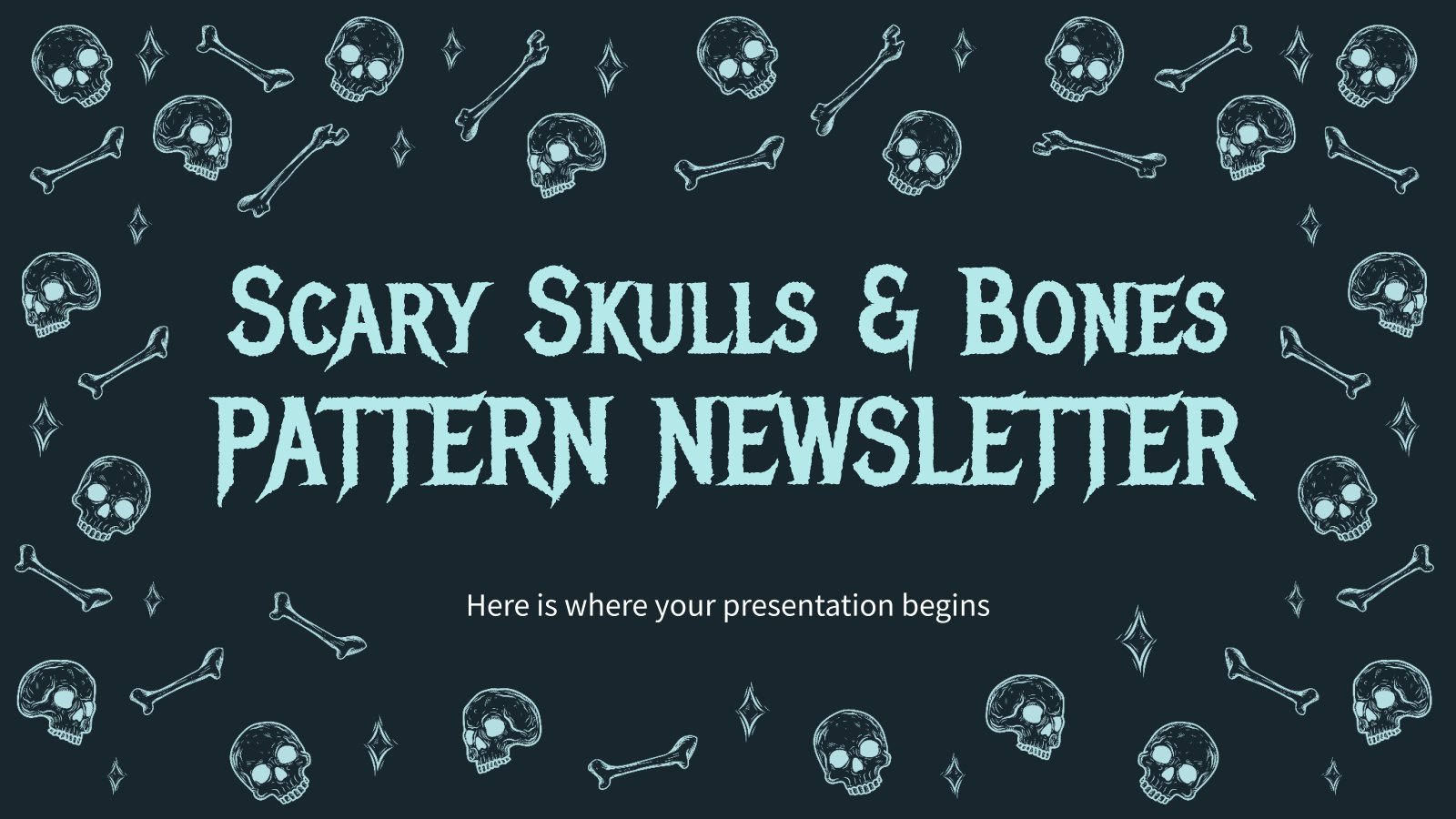
frankenstein
22 templates

el salvador
32 templates

summer vacation
19 templates

44 templates

17 templates

pediatrician
27 templates
Medical Devices Innovation
Medical devices innovation presentation, free google slides theme and powerpoint template.
Transcend the boundaries of typical presentations with this Google Slides and PowerPoint template. With its uncluttered, light gray design, this fully customizable resource allows you to explore the revolution in medicinal practices brought on by advancements in medical machinery and devices. Use the integrated graphs and infographics to visually demonstrate the process of innovation, regulatory compliance, and the colossal impact these pioneering inventions have made in reshaping the medical landscape. Pay tribute to the brilliant minds behind life-changing medical devices!
Features of this template
- 100% editable and easy to modify
- 35 different slides to impress your audience
- Contains easy-to-edit graphics such as graphs, maps, tables, timelines and mockups
- Includes 500+ icons and Flaticon’s extension for customizing your slides
- Designed to be used in Google Slides and Microsoft PowerPoint
- 16:9 widescreen format suitable for all types of screens
- Includes information about fonts, colors, and credits of the resources used
How can I use the template?
Am I free to use the templates?
How to attribute?
Attribution required If you are a free user, you must attribute Slidesgo by keeping the slide where the credits appear. How to attribute?
Related posts on our blog.

How to Add, Duplicate, Move, Delete or Hide Slides in Google Slides

How to Change Layouts in PowerPoint

How to Change the Slide Size in Google Slides
Related presentations.

Premium template
Unlock this template and gain unlimited access

Register for free and start editing online
- Recommended

Tips and tricks for presenting research at a medical conference as a premed
Last summer, I had the incredible opportunity to present a case report as a poster at the Women in Ophthalmology Summer Symposium. As a premed student, this was exciting but also quite intimidating.
This meeting is a large national medical conference with about 1,500 attendees, including ophthalmologists of all career stages, many ophthalmology residents, and medical students interested in ophthalmology. I presented the case of a child who had experienced retinopathy as a side effect of an MEK inhibitor chemotherapeutic, a complication well-known in adults but rarely reported in children. The poster presenters at the conference were placed into groups of 10, divided by subspecialty/poster topic, with a moderator to ensure that presentations stayed within their time limits and to help facilitate discussion and questions following each presentation. For me, this meant that not only was every presenter (except for me) in my group a physician, but they were all also experts in the field of my case, neuro-ophthalmology. I was assigned to present last in my group. While listening to these phenomenal women present their research, I paid careful attention to not only the subject matter but also how it was presented. I mentally noted what I liked and wanted to emulate in my presentation, and what I didn’t like and wanted to avoid. When it was finally my turn to present, I was excited and very nervous. I put on my best brave face, ran over the pronunciation of a few particularly difficult words in my head (hoping not to embarrass myself in front of this group of experts), flashed a confident smile, and began the presentation I had practiced in the mirror so many times.
I was amazed by the support and encouragement I received from the women in my group of presenters as well as the small audience that we had garnered. Although I was not the most expert person there, I was the most expert on my presentation. My preparation paid off, and it felt amazing to present my research to people who were interested and knowledgeable in the field rather than my dog, my business major friends who had no idea what I was talking about, and my parents who had listened to me practice about 100 times too many.
Through my own preparation, observing others present, and my own experience presenting research at a medical conference, I have picked up a few tips and tricks.
When you are practicing, practice out loud. This may seem obvious, but it is much easier to go over things in your head than it is to say the words out loud. It may feel awkward at first, but practice alone in the mirror, record yourself and make yourself listen to the recording, or present your research to anyone who will listen (even your dog). While you are practicing, make sure to time yourself. Many conferences adhere to strict timing and the last thing that you want on presentation day is to be cut off and not able to finish your presentation or run over your allotted time. If in doubt, it is almost always better to be a bit under the time limit rather than any amount over the time limit. The more comfortable you get with presenting out loud, the less you will need to rely on reading off your poster or notes, the more comfortable you will be with your timing, and the less likely you are to stumble over your words. (Even those tricky five-syllable medical terms!)
Prior to your presentation, check out the space where you will be present. Take a mental note of what the acoustics are like in the room, where exactly you need to stand, how the technology that you will use works, etc. When you return for your actual presentation, you will feel so much more comfortable and relaxed if you know what to expect.
During your presentation, avoid reading from your poster or notes. Instead, make eye contact with the people who have come to listen to what you have to say. Speak loudly and animatedly. This project is likely something you are passionate about and have worked hard on—let it show! Try your hardest not to fidget with your hands or with your clothing. This is more distracting than you may think to your audience.
The most anxiety-producing aspect of presenting my research for me was the questions that I knew would follow my presentation. I was able to prepare for my presentation, but I had no clue what people would ask afterward. What I learned was that it is okay if you don’t know the answer to someone’s question. If someone asks a question that you don’t know the answer to, admit that you don’t know, never make anything up, and shift the conversation to talk about what you do know.
Despite the nerves that accompanied it, my experience presenting research at the Women in Ophthalmology Summer Symposium was extremely rewarding. Not only did I present something that I was proud of, but the conference’s supportive environment allowed me to make connections with remarkably smart, kind, inspiring, and empowering women who offered me mentorship and friendship.
Natalie Enyedi is a premedical student.

A doctor's struggle for patient care

Apple's OpenGL and iOS 18: Shaping the future of health care technology

Tagged as: Medical school
More by Natalie Enyedi

Practicing patience with patients

The unspoken skill of touch in health care

Medical school gap year: Why working as a medical assistant is perfect
Related posts.

8 scholarship tips for medical school

Beyond Jimmy Buffet: The new medical conference

9 medical student tips to prepare for the Match

5 tips for surviving your first year in medical school

How the COVID-19 pandemic highlights the need for social media training in medical education

New medical students: Here are 10 tips for success
More in education.

Navigating post-match disappointment: What to do if you did not match

Dealing with discouragement: strategies for aspiring medical students

Why South Korean resident physicians are quitting

Ode to the gap year(s) before medical school
From numbness to empathy: a reflection on medical practice, most popular.

Medicine’s struggle for inclusivity

Your A+ in anatomy and physiology won’t improve the American health care system

Unworthiness nearly killed me

A doctor’s struggle for patient care

Breaking free from denial: Embracing the truth
![Physician autonomy with self-employment [PODCAST] presentation topics medical](https://www.kevinmd.com/wp-content/uploads/Physician-autonomy-with-self-employment-190x100.jpg)
Physician autonomy with self-employment [PODCAST]
Past 6 months.

Real pain deserves real treatment

Medicine is not apolitical: Your vote dictates your ability to practice medicine

Venture-backed telemental health care companies are creating a new opioid epidemic

Elite access vs. public scrutiny: Medication disparities exposed
Recent posts.

Navigating grief and stress: Embracing catharsis

Apple’s OpenGL and iOS 18: Shaping the future of health care technology

AI in American medicine [PODCAST]
Subscribe to kevinmd and never miss a story.
Get free updates delivered free to your inbox.
Find jobs at Careers by KevinMD.com
Search thousands of physician, PA, NP, and CRNA jobs now.
CME Spotlights
Leave a Comment
Comments are moderated before they are published. Please read the comment policy .

- SUGGESTED TOPICS
- The Magazine
- Newsletters
- Managing Yourself
- Managing Teams
- Work-life Balance
- The Big Idea
- Data & Visuals
- Reading Lists
- Case Selections
- HBR Learning
- Topic Feeds
- Account Settings
- Email Preferences
How to Make a “Good” Presentation “Great”
- Guy Kawasaki

Remember: Less is more.
A strong presentation is so much more than information pasted onto a series of slides with fancy backgrounds. Whether you’re pitching an idea, reporting market research, or sharing something else, a great presentation can give you a competitive advantage, and be a powerful tool when aiming to persuade, educate, or inspire others. Here are some unique elements that make a presentation stand out.
- Fonts: Sans Serif fonts such as Helvetica or Arial are preferred for their clean lines, which make them easy to digest at various sizes and distances. Limit the number of font styles to two: one for headings and another for body text, to avoid visual confusion or distractions.
- Colors: Colors can evoke emotions and highlight critical points, but their overuse can lead to a cluttered and confusing presentation. A limited palette of two to three main colors, complemented by a simple background, can help you draw attention to key elements without overwhelming the audience.
- Pictures: Pictures can communicate complex ideas quickly and memorably but choosing the right images is key. Images or pictures should be big (perhaps 20-25% of the page), bold, and have a clear purpose that complements the slide’s text.
- Layout: Don’t overcrowd your slides with too much information. When in doubt, adhere to the principle of simplicity, and aim for a clean and uncluttered layout with plenty of white space around text and images. Think phrases and bullets, not sentences.
As an intern or early career professional, chances are that you’ll be tasked with making or giving a presentation in the near future. Whether you’re pitching an idea, reporting market research, or sharing something else, a great presentation can give you a competitive advantage, and be a powerful tool when aiming to persuade, educate, or inspire others.
- Guy Kawasaki is the chief evangelist at Canva and was the former chief evangelist at Apple. Guy is the author of 16 books including Think Remarkable : 9 Paths to Transform Your Life and Make a Difference.
Partner Center
Neurosyphilis in the modern era: Literature review and case series
Affiliations.
- 1 Lomonosov Moscow State University, Faculty of Fundamental Medicine, Moscow, Russia; Bujanov Moscow City Clinical Hospital, Moscow, Russia.
- 2 Institute of Higher Nervous Activity and Neurophysiology, Moscow, Russia; Bujanov Moscow City Clinical Hospital, Moscow, Russia. Electronic address: [email protected].
- 3 Bujanov Moscow City Clinical Hospital, Moscow, Russia.
- 4 Moscow Scientific and Practical Center for Dermatology, Venerology and Cosmetology, Moscow Healthcare Department, Russia.
- 5 Institute of Higher Nervous Activity and Neurophysiology, Moscow, Russia; Bujanov Moscow City Clinical Hospital, Moscow, Russia; Moscow Research and Clinical Center for Neuropsychiatry, Moscow Healthcare Department, Russia.
- 6 Moscow Research and Clinical Center for Neuropsychiatry, Moscow Healthcare Department, Russia; Pirogov Russian National Research Medical University, Moscow, Russia.
- PMID: 31427238
- DOI: 10.1016/j.jocn.2019.08.033
The term of neurosyphilis (NS) refers to infection of central nervous system by Treponema pallidum. Classically, it has been divided into early (meningitis, meningovascular) and late forms (general paresis and tabes dorsalis). The availability of penicillin and high sensitivity of Treponema pallidum to this antibiotic has led to a widely held perception about rarity of syphilitic forms with central nervous system involvement. However, patient can exhibit atypical clinical presentation. Recently different clinical cases with autoimmune encephalitis-mimicking presentation or atypical movement disorders were described. In this article we presented clinical case series with different clinical and MRI presentation and discuss diagnostic and treatment challenges. During our screening period at neurological department we revealed 6 NS cases. Three of them have an atypical presentation. The first patient was misdiagnosed as acute disseminated encephalomyelitis, the second patient had hippocampal sclerosis and epileptic seizures. Another patient had cognitive decline and autoimmune encephalitis-like MRI lesions. We put an emphasis on widening of indication for lumbar puncture and NS tests in patients with syphilitic anamnesis and neurological manifestations.
Keywords: Atypical cases; CSF tests; MRI; Neurosyphilis.
Copyright © 2019 Elsevier Ltd. All rights reserved.
Publication types
- Case Reports
- Anti-Bacterial Agents / therapeutic use
- Middle Aged
- Neurosyphilis / complications
- Neurosyphilis / diagnosis*
- Neurosyphilis / drug therapy
- Treponema pallidum
- Anti-Bacterial Agents
Skip to content
Read the latest news stories about Mailman faculty, research, and events.
Departments
We integrate an innovative skills-based curriculum, research collaborations, and hands-on field experience to prepare students.
Learn more about our research centers, which focus on critical issues in public health.
Our Faculty
Meet the faculty of the Mailman School of Public Health.
Become a Student
Life and community, how to apply.
Learn how to apply to the Mailman School of Public Health.
Conference Facilitates Talk on Hot Topics in Health Policy and Management
From artificial intelligence to alternative medicine and quality care to communications: the annual Health Policy and Management (HPM) Healthcare Conference was a sounding board for ideas on all manner of timely issues affecting organizational leaders, policymakers, and not least, everyone at the receiving end of health care services. The all-day event on April 12 brought together faculty, students, policymakers, and industry leaders. The event was sponsored by The Commonwealth Fund and held at Columbia University event space The Forum.
Sherry Glied, Dean of New York University’s Robert F. Wagner Graduate School of Public Service and former HPM chair, opened the conference with a keynote address on the future of healthcare in New York State and beyond. Glied, who chairs the New York State Commission of the Future of Healthcare, said her goal was to recommit the state to measuring success through “the health and well-being of individual people.”
A morning panel titled Communicating Topics in Public Health Effectively shed light on strategies to convey health information to the public despite the challenging political environment. HPM Professor Robert Shepardson moderated the panel, which included White House Assistant Press Secretary Kevin Munoz, Deputy Assistant Secretary for Strategic Planning and Speechwriter for U.S. Department of Health and Human Services Brian Reich, and Environmental Health Sciences Professor Julie Herbstman . When asked why communications is important, Herbstman, who is director of Columbia Center for Children’s Environmental Health noted, “I love working with data, but the reason I’m doing public health research is so that it goes somewhere, it has some kind of impact. My job isn’t done when I publish a paper.”
Afternoon sessions covered topics including food justice, developments in alternative medicine, PEPFAR reauthorization, and a lunch salon focused on digital health. The latter discussion was led by HPM student Andera Marx, senior marketing manager at Amazon Health Services and senior product marketing manager at One Medical.
The closing panel considered the deployment of AI in healthcare and what that could mean for equitable access to services. Columbia Mailman Biostatistics Professor and Associate Dean for Data Science Jeff Goldsmith moderated the event, which included panelists Julia Iyasere, director of the Dalio Center of Health Justice; Ashley Beecy, medical director of AI Operations at NewYork-Presbyterian; and physician-strategist Rebecca Winkour.
The day concluded with a networking reception and panel for admitted students led by current master’s students. Amey Kamdar, MHA ’24, appreciated how the conference brought together providers, researchers, policymakers, and students, adding, “That made for great dialogue and broadening of horizons.” HPM Chair and Professor of Health Policy and Management Michael Sparer echoed Kamdar’s comments, saying, “This is a special day where we come together once a year and we hear great talks, but we also have an opportunity to network and be with each other.”
Advancing social justice, promoting decent work ILO is a specialized agency of the United Nations

World Day for Safety and Health at Work 2024
As climate change intensifies, workers around the globe find themselves at an increased risk of exposure to hazards such as excessive heat , ultraviolet radiation , extreme weather events , air pollution , vector-borne diseases and agrochemicals .
The time to act is now!
- Press Release: Climate change creates a ‘cocktail’ of serious health hazards for 70 per cent of the world’s workers, ILO report finds

Global debate on climate change and occupational safety and health
Experts, employers, workers and other guests discussed how to address impacts of climate change on occupational safety and health.
- View the recording of the event

Ensuring safety and health at work in a changing climate
- Report at a glance
- Promotional Materials

News and Updates
- Press Conference at the United Nations, Geneva (22 April 2024)

Email: [email protected]

Email: [email protected]
share this!
April 26, 2024
This article has been reviewed according to Science X's editorial process and policies . Editors have highlighted the following attributes while ensuring the content's credibility:
fact-checked
CRISPR is promising to tackle antimicrobial resistance, but bacteria can fight back
by European Society of Clinical Microbiology and Infectious Diseases
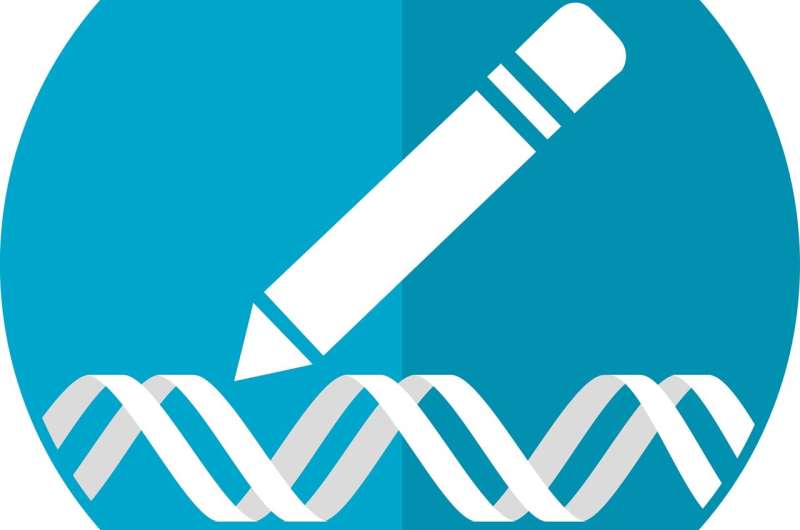
In his presentation "How to use CRISPR-Cas to combat AMR" at the ESCMID Global Congress , Assistant Prof. Ibrahim Bitar, Department of Microbiology, Faculty of Medicine and University Hospital in Plzen, Charles University in Prague, Plzen, Czech Republic, will give an overview of the molecular biology of CRISPR technology in explaining how it can used to tackle antimicrobial resistance.
Clustered regularly interspaced short palindromic repeats (CRISPRs) and CRISPR associated genes (cas) are widespread in the genome of many bacteria and are a defense mechanism against foreign invaders such as plasmids and viruses. The CRISPR arrays are composed of a repeated array of short sequences, each originating from and exactly matching a nucleic acid sequence that once invaded the host.
Accompanying CRISPR sequences, there are 4-10 CRISPR-associated genes (cas), which are highly conserved and encode the Cas proteins. Cas proteins conduct adaptive immunity in prokaryotes (bacteria) based on immunological memories stored in the CRISPR array.
The CRISPR/Cas system integrates a small piece of foreign DNA from invaders such as plasmids and viruses into their direct repeat sequences and will recognize and degrade the same external DNA elements during future invasions.
As the CRISPR/Cas systems integrate DNA from invading pathogens in chronical order, genotyping can be used to trace the clonality and the origin of the isolates and define them as a population of strains that were subjected to the same environmental conditions including geographic location (region) and community/hospital settings and eventually further extended to track pathogenic bacteria around human society.
CRISPR/Cas systems can also be employed for developing antimicrobial agents: introduction of self-targeting crRNAs will effectively and selectively kill target bacterial populations. Due to the shortage of available effective antimicrobial agents in treating multidrug-resistant (MDR) infections, researchers started to search for alternative methods to fight MDR infections rather than going through the process of developing new antimicrobial agents which can go on for decades.
As a result, the concept of CRISPR/Cas-based selective antimicrobials was first developed and demonstrated in 2014. Vectors coding Cas9 and guide RNAs targeting genomic loci of a specific bacterial strain/species can be delivered to the target strain via bacteriophages or conjugative bacterial strains.
In theory, delivery of the engineered CRISPR/Cas systems specifically eliminates target strains from the bacterial population, yet it is not that simple.
While these systems can seem a target for manipulation/intervention, all bacteria are regulated by multiple pathways to ensure the bacteria retains control over the process. Therefore, there remain several major challenges in using this system as an antimicrobial agent.
Most methods require delivery of the re-sensitized system by conjugation; the vector is carried by a non-virulent lab strain bacteria that is supposed to go and share the vector/plasmid through conjugation. The conjugation process is a natural process that the bacteria do which results in sharing plasmids among each other (even with other species).
The percentage of conjugated (successfully delivered) bacteria in the total bacterial population is critical to the re-sensitized efficiency. This process is governed by several complicated pathways.
Bacteria also possess built-in anti-CRISPR systems, that can repair any damage caused by CRISPR-Cas systems.
Defense systems that the bacteria uses to protect itself from foreign DNA often co-localize within defense islands (genomic segments that contain genes with similar function in protecting the host from invaders) in bacterial genomes; for example: acr (a gene that acts, with other similar variants, as a repressor of plasmid conjugative systems) often cluster with antagonists of other host defense functions (e.g., anti-restriction modification systems) and experts hypothesize that MGEs (mobile genetic elements) organize their counter defense strategies in "anti-defense" islands.
Assistant Professor Bitar concludes, "In summary, this method seems very promising as an alternative way of fighting antimicrobial resistance. The method uses the concept of re-sensitizing the bacteria in order to make use of already available antibiotics—in other words, removing their resistance and making them vulnerable again to first-line antibiotics.
"Nevertheless, the bacterial pathways are always complicated and such systems are always heavily regulated by multiple pathways. These regulated pathways must be studied in depth in order to avoid selective pressure favoring anti-CRISPR systems activation, hence prevalence of resistance in a more aggressive manner."
Provided by European Society of Clinical Microbiology and Infectious Diseases
Explore further
Feedback to editors

Optical barcodes expand range of high-resolution sensor
15 hours ago

Ridesourcing platforms thrive on socio-economic inequality, say researchers

Did Vesuvius bury the home of the first Roman emperor?

Florida dolphin found with highly pathogenic avian flu: Report

A new way to study and help prevent landslides

New algorithm cuts through 'noisy' data to better predict tipping points
16 hours ago

Researchers reconstruct landscapes that greeted the first humans in Australia around 65,000 years ago

High-precision blood glucose level prediction achieved by few-molecule reservoir computing
17 hours ago

Enhancing memory technology: Multiferroic nanodots for low-power magnetic storage

Researchers advance detection of gravitational waves to study collisions of neutron stars and black holes
Relevant physicsforums posts, the cass report (uk).
Apr 24, 2024
Major Evolution in Action
Apr 22, 2024
If theres a 15% probability each month of getting a woman pregnant...
Apr 19, 2024
Can four legged animals drink from beneath their feet?
Apr 15, 2024
Mold in Plastic Water Bottles? What does it eat?
Apr 14, 2024
Dolphins don't breathe through their esophagus
More from Biology and Medical
Related Stories

Researchers systematically investigate efficacy of CRISPR antimicrobial agents
Apr 25, 2024

Scientists uncover new way viruses fight back against bacteria
Oct 18, 2023

Genetically engineered plasmid can be used to fight antimicrobial resistance
Sep 16, 2019

Gene editing tool could help reduce spread of antimicrobial resistance
May 25, 2023

New bacterial defense mechanism of the CRISPR-Cas system uncovered
Jul 18, 2017
Recommended for you

Study suggests host response needs to be studied along with other bacteriophage research
18 hours ago

Automated machine learning robot unlocks new potential for genetics research

Study details a common bacterial defense against viral infection

AI deciphers new gene regulatory code in plants and makes accurate predictions for newly sequenced genomes

Scientists discover higher levels of CO₂ increase survival of viruses in the air and transmission risk

Researchers decipher how an enzyme modifies the genetic material in the cell nucleus
Let us know if there is a problem with our content.
Use this form if you have come across a typo, inaccuracy or would like to send an edit request for the content on this page. For general inquiries, please use our contact form . For general feedback, use the public comments section below (please adhere to guidelines ).
Please select the most appropriate category to facilitate processing of your request
Thank you for taking time to provide your feedback to the editors.
Your feedback is important to us. However, we do not guarantee individual replies due to the high volume of messages.
E-mail the story
Your email address is used only to let the recipient know who sent the email. Neither your address nor the recipient's address will be used for any other purpose. The information you enter will appear in your e-mail message and is not retained by Phys.org in any form.
Newsletter sign up
Get weekly and/or daily updates delivered to your inbox. You can unsubscribe at any time and we'll never share your details to third parties.
More information Privacy policy
Donate and enjoy an ad-free experience
We keep our content available to everyone. Consider supporting Science X's mission by getting a premium account.
E-mail newsletter
- Share this page on Facebook
- Share this page on Twitter
- Share this page on Linked In
- Email this page
Honors Nurses Present in Salt Lake City
Six Honors College students in the College of Nursing presented their research at the 2024 Western Institute of Nursing Conference in Salt Lake City. The presentations covered a range of healthcare topics:
Carolyn Stone * and Ekatrina Burduli Mental health and Birth Satisfaction of Perinatal Individuals During the COVID-19 Pandemic.
Rosie Kirker *, Sheila Hurst, Britanny Bannon, Carolyn Stone , Dena Carr, Sharon Stadelman Sleep Distrubance and Challenges Faced by People Experiencing Houselessness
Destiny Stanek Bolles*, Janessa Graves, Sheila Hurst, Shawna Beese: The Relationship Between Attention Deficit Hyperactivity Disorder (ADHD) and Autism Spectrum Disorder (ASD) among All of us Respondents.
Macy Johnston *, Janessa Graves, Sheila Hurst, Shawna Beese: Exploring Access to Outdoor Physical Activity and Stress in NIH All of Us Research Program
Amelia Kohut*, Janessa Graves, Sheila Hurst, Shawna Beese: The Relationship Between Food Insecurity and Perceived Stress
Bianca Gerghe*, Janessa Graves, Sheila Hurst, Shawna Beese: Mental Health Service Utilization Among Pregnant Women in NIH All of US Research Program
Angela Crable, Jenifer Brewer, Molly Parker, Tara Marko, Natasha Barrow, Amelia Kohut , Sheila Hurst, Julie Postma: Assessing Nursing Curriculum Using the Planetary Health Report Card
Sheila Hurst, Brittany Bannon Dena Carr, Sharon Stadelman, Charis Williams, Carolyn Stone, Grace Borchert, Morgan Erickson , Marian Wilson: Sleep Assessment Among Houseless Individuals
- Alzheimer's disease & dementia
- Arthritis & Rheumatism
- Attention deficit disorders
- Autism spectrum disorders
- Biomedical technology
- Diseases, Conditions, Syndromes
- Endocrinology & Metabolism
- Gastroenterology
- Gerontology & Geriatrics
- Health informatics
- Inflammatory disorders
- Medical economics
- Medical research
- Medications
- Neuroscience
- Obstetrics & gynaecology
- Oncology & Cancer
- Ophthalmology
- Overweight & Obesity
- Parkinson's & Movement disorders
- Psychology & Psychiatry
- Radiology & Imaging
- Sleep disorders
- Sports medicine & Kinesiology
- Vaccination
- Breast cancer
- Cardiovascular disease
- Chronic obstructive pulmonary disease
- Colon cancer
- Coronary artery disease
- Heart attack
- Heart disease
- High blood pressure
- Kidney disease
- Lung cancer
- Multiple sclerosis
- Myocardial infarction
- Ovarian cancer
- Post traumatic stress disorder
- Rheumatoid arthritis
- Schizophrenia
- Skin cancer
- Type 2 diabetes
- Full List »
share this!
April 26, 2024
This article has been reviewed according to Science X's editorial process and policies . Editors have highlighted the following attributes while ensuring the content's credibility:
fact-checked
Experts develop immune-enhancing therapies to target tuberculosis
by European Society of Clinical Microbiology and Infectious Diseases

Experts are working on novel immune-enhancing therapies called host-directed therapies to use the body's own immune system to target tuberculosis, with hopes that they could tackle even the drug-resistant forms of the disease. In a presentation at this year's ESCMID Global Congress (formerly ECCMID) in Barcelona (27–30 April), Associate Professor Susanna Brighenti, Center for Infectious Medicine (CIM), ANA Futura at the Karolinska Institutet, Stockholm, Sweden, presents work being done in this area by a collaboration of scientists.
The reported global number of people newly diagnosed with TB was 7.5 million in 2022, causing an estimated 1.3 million deaths. As estimated 410,000 cases and 160,000 deaths were due to multidrug-resistant TB (MDR-TB).
"Mycobacterium tuberculosis (Mtb) have evolved a remarkable ability to manipulate the human immune response and undermine antimicrobial effector functions in host immune cells," explains Assoc Professor Brighenti.
"While some new antimicrobial therapies are coming through, treatment with antibiotics remains an intensive and long process even for drug-susceptible forms of the disease. Importantly, mutations conferring antibiotic resistance are intrinsic properties of mycobacteria that effectively develop resistance to old as well as new groups of antibiotics, accentuating the need for adjunct treatments. Thus, new treatments are going to be absolutely vital in the battle against TB."
Host-directed therapies (HDT) aim to strengthen the body's immune responses and represent an underexplored opportunity to improve treatment of TB, particularly MDR-TB. HDT are designed to target several immune pathways in infected cells to restore or induce antimicrobial functions instead of inhibiting bacterial growth directly.
This may involve enhanced production of immune peptides or toxic molecules that contribute to bacterial killing, but it could also include rebalancing of inflammatory responses. Assoc Professor Brighenti will explain how her research collaboration has generated a platform for immune reconstitution in TB, using small molecule compounds including histone deacetylase (HDAC) inhibitors.
"These drugs can regulate transcription of genes in cells such as those in the immune system, and thus enhance the expression of proteins associated with the antibacterial host defense. We have identified several HDAC inhibitors that reduce Mtb growth inside immune cells by some 50–75%, even in the absence of antibiotics," she explains.
"That may not sound so impressive, but these immunomodulatory compounds could work well as a complement to standard therapy and exert additive or synergistic effects together with the antibiotics. This would provide the possibility to reduce the dose and treatment length required with antibiotics to improve patient outcomes."
In this way, it is conceivable that the effect of existing antibiotics could be guarded by add-on therapies that restore protective immunity and limit excess inflammation and/or immunosuppression in patients with TB.
Standard anti-TB treatment involves daily administration of 4-9 antibiotics, but instead of adding yet another antimicrobial drug to the regimen, an immune-enhancing compound could promote clinical recovery of patients with severe forms of TB and poor prognosis, especially MDR-TB.
Assoc Prof Brighenti says, "Implementation of immunotherapy as a complement to standard therapy has revolutionized the treatment of cancer, autoimmunity, and asthma/allergy. Similarly, our research on immune enhancement as a complement to antibiotics may become a game-changing treatment option for patients with TB that has the potential to impact clinical management and prevent spread of TB infections and drug resistance in this pivotal moment in our history when antimicrobial resistance constitutes a serious threat to human health."
She adds, "Short-term, approved and already available 'off-the-shelf' therapeutics would represent an initial logical step to implement HDTs of patients with TB. This could include for example, HDTs based on glucocorticoid treatment or cytokine neutralization (eg. anti-IL-6, anti-1β) to reduce inflammation, while metformin, or non-steroidal anti-inflammatory drugs may also promote or rewire the immune response.
"Long-term, more precise immunomodulatory interventions in TB such as local administration of specific HDAC inhibitors, can be tested in clinical trials with the aim to customize therapy for patients with MDR-TB.
"Today, several HDAC inhibitors are FDA-approved for different diseases—for example, Vorinostat, Belinostat, and Panobinostat for different cancers, Phenylbutyrate for urea cycle disorders and Givinostat for Duchenne muscular dystrophy , while the ones we have found to be most effective to reduce intracellular M. tuberculosis growth needs to be first tested in pre-clinical models for toxicity and efficacy before progressing to clinical trials."
Importantly, like many other diseases, TB can be divided into different sub-groups and using a one-fits-all approach to treatment is not necessarily best. Tailored treatments that are optimized to individual patient needs, so-called personalized medicine, will also be part of the future for TB management.
Explore further
Feedback to editors

Gene linked to epilepsy and autism decoded in new study
15 hours ago

Blood test finds knee osteoarthritis up to eight years before it appears on X-rays

Researchers find pregnancy cytokine levels impact fetal brain development and offspring behavior

Study finds biomarkers for psychiatric symptoms in patients with rare genetic condition 22q
16 hours ago

Clinical trial evaluates azithromycin for preventing chronic lung disease in premature babies
17 hours ago

Scientists report that new gene therapy slows down amyotrophic lateral sclerosis disease progression

Using stem cell-derived heart muscle cells to advance heart regenerative therapy

Analysis identifies 50 new genomic regions associated with kidney cancer risk

Illusion demystifies the way vision works: Experiments imply brightness perception occurs deeper in brain than thought
18 hours ago

How buildings influence the microbiome and human health
Related stories.

Antibiotics reveal a new way to fight cancer
Apr 16, 2024

Cancer therapy shows promise against tuberculosis
Nov 16, 2023

Progress towards new treatments for tuberculosis
Jul 12, 2021

Study: Key mechanisms of action differences in immune checkpoint inhibitor combination therapies for advanced melanoma
Dec 8, 2023

Study finds commensal gut bacteria develop resistance in response to antibacterial treatment
Jan 30, 2024

Scientists discover how anti-viral cytokines can blunt the immune response to tuberculosis
Jul 3, 2023
Recommended for you

Biomarkers identified for successful treatment of bone marrow tumors

New research sheds light on the weakening immune response observed in older adults
19 hours ago

How the immune system learns from harmless particles

Study reports new compound that halts replication of COVID by targeting 'Mac-1' protein in cell models
Apr 25, 2024
Let us know if there is a problem with our content
Use this form if you have come across a typo, inaccuracy or would like to send an edit request for the content on this page. For general inquiries, please use our contact form . For general feedback, use the public comments section below (please adhere to guidelines ).
Please select the most appropriate category to facilitate processing of your request
Thank you for taking time to provide your feedback to the editors.
Your feedback is important to us. However, we do not guarantee individual replies due to the high volume of messages.
E-mail the story
Your email address is used only to let the recipient know who sent the email. Neither your address nor the recipient's address will be used for any other purpose. The information you enter will appear in your e-mail message and is not retained by Medical Xpress in any form.
Newsletter sign up
Get weekly and/or daily updates delivered to your inbox. You can unsubscribe at any time and we'll never share your details to third parties.
More information Privacy policy
Donate and enjoy an ad-free experience
We keep our content available to everyone. Consider supporting Science X's mission by getting a premium account.
E-mail newsletter

IMAGES
VIDEO
COMMENTS
Water and community health. When to Call 911. Women's Health. Work Injury Management. Working environment and community health. Worksite Wellness. Xenobiotics. Yoga in health and disease. Hope this list of healthcare and medical presentation topics will help you prepare stunning presentations for school, college and other power-point ...
And this pause can be delivered in a number of ways. First, you can separate your presentation into several sections, thereby helping your audience navigate the overall flow of what you're saying. For example: 'Key findings', 'What this means for the medical world', and 'Next steps'.
Introducing 30 Top Medical Presentation Ideas with free templates. Explore a diverse collection of professionally designed presentation templates, each tailored to showcase different facets of the medical field. ... This template is the ideal choice for presentations that encompass a wide spectrum of medical topics, from drug discovery and ...
Giving an Effective Poster Presentation (freely available, video). This video shows medical students in action presenting their work and shares strategies for presenting your poster in a conversational style, preparing for questions, and engaging viewers. (Skills addressed: 2,3) Better Scientific Poster (freely available, toolkit).
Medical presentations are a helpful tool for medical professionals, research clinics, and organizations to help inform and educate their communities on a wide variety of urgent topics. This can include patient treatment, clinical trial research and results, training for medical staff, general education, medical research, or important data ...
Presentations on health and medical topics can be challenging to create, but this Google Slides & PowerPoint template is here to rescue you! This multi-purpose layout is designed with blue pastel tones, providing a professional and calm environment to showcase your medical expertise to colleagues, students, or patients. The template...
0 shares Share0 Share +10 Tweet0 Pin0 Share0 About Medical PresentationsMedical presentations are fundamentally different from other presentation types. In fact, they are one of the toughest type of presentations to design.Medical slides have research facts, data charts, diagrams and illustrations that demand a totally different approach to design. You need a slide creation method […]
These templates can also be used in Google Slides and Canva, giving you even more options for creating a stunning presentation. Use them to analyze data, manage lessons or workshops, and present your findings in a professional manner. With these medical PowerPoint templates, you'll be able to make a lasting impression on your audience.
Choosing the suitable template for your medical presentation depends on your topic, audience, and tone. When your present to a group of medical professionals like yourself, you can go crazy with the jargon and stick to neutral-colored and concise designs. If you're doing a demo for students, make your medical slide templates engaging with ...
Enhance medical communication with Venngage's specialized presentation templates, merging informative content with clear visuals seamlessly. Create impactful medical presentations that effectively convey complex concepts, catering to healthcare professionals, researchers, and educators seeking to communicate with precision and impact.
If you want to explain medical concepts or demonstrate a new medical invention, you'd better use medical presentations in PowerPoint. It allows you to make your slides modern & visually appealing with a few creative design moves. Suppose you need to illustrate a healthcare document or make a presentation on a medical topic.
Explain your services, medical terms, and raise awareness about specific topics with these amazing designs! Medical PowerPoint Template. This beautifully designed free healthcare PowerPoint template has all the tools you might need for a medical presentation. It has slides you can use to showcase different procedure options or different service ...
Yes, Medical Presentation Templates are highly customizable. They are designed to function as a flexible starting point, allowing users to easily modify elements like colors, fonts, images, graphics, charts and other design components. These customizable features allow you to tailor the template to match your specific needs and style preferences.
Medical speech topic list with public speaking ideas for an informative or persuasive medical text such as speech recognition software, Staphylococcus aureus or self-esteem problems. ... In other articles and entirely new threads I have written detailed tips to convert them into a real public speaking presentation. Tip: A good topic title is ...
Health Presentation templates Find Google Slides themes or download our PPT files for PowerPoint or Keynote to give a presentation about any topic related to Health. Share your medical projects with the community. Related collections . Pre-K. 35 templates. Elementary. 54 templates. Middle School. 60 templates. High School ...
For example, premed students have a different understanding of medical topics than medical students. A presentation on the same subject should be different for both groups. ... There are some basic steps to achieving an excellent presentation: know the topic well, understand who you're presenting to, develop a memorable story, and practice ...
Free Google Slides theme and PowerPoint template. Transcend the boundaries of typical presentations with this Google Slides and PowerPoint template. With its uncluttered, light gray design, this fully customizable resource allows you to explore the revolution in medicinal practices brought on by advancements in medical machinery and devices.
All Medscape Topics. A. Acne. Acute Coronary Syndromes (ACS) Acute Leukemia. ADHD. Adolescent Medicine. Aesthetic Medicine. Affordable Care Act (ACA)
Some of the best presentation topic ideas for students center around topics such as current events, education, general culture, health, life skills, literature, media and science. When picking presentation topics, consider these things: your hobbies, the books you read, the kind of TV shows you watch, what topics you're good at and what you ...
This meeting is a large national medical conference with about 1,500 attendees, including ophthalmologists of all career stages, many ophthalmology residents, and medical students interested in ophthalmology. ... divided by subspecialty/poster topic, with a moderator to ensure that presentations stayed within their time limits and to help ...
Summary. A strong presentation is so much more than information pasted onto a series of slides with fancy backgrounds. Whether you're pitching an idea, reporting market research, or sharing ...
The term of neurosyphilis (NS) refers to infection of central nervous system by Treponema pallidum. Classically, it has been divided into early (meningitis, meningovascular) and late forms (general paresis and tabes dorsalis). The availability of penicillin and high sensitivity of Treponema pallidum to this antibiotic has led to a widely held ...
From artificial intelligence to alternative medicine and quality care to communications: the annual Health Policy and Management (HPM) Healthcare Conference was a sounding board for ideas on all manner of timely issues affecting organizational leaders, policymakers, and not least, everyone at the receiving end of health care services. The all-day event on April 12 brought together faculty ...
As climate change intensifies, workers around the globe find themselves at an increased risk of exposure to hazards such as excessive heat, ultraviolet radiation, extreme weather events, air pollution, vector-borne diseases and agrochemicals.. The time to act is now!
In his presentation "How to use CRISPR-Cas to combat AMR" at the ESCMID Global Congress, Assistant Prof. Ibrahim Bitar, Department of Microbiology, Faculty of Medicine and University Hospital in ...
Honors Nurses Present in Salt Lake City Six Honors College students in the College of Nursing presented their research at the 2024 Western Institute of Nursing Conference in Salt Lake City. The presentations covered a range of healthcare topics: Carolyn Stone* and Ekatrina Burduli Mental health and Birth Satisfaction of Perinatal Individuals During the COVID-19
Students can undergo a mandatory annual medical examination at the polyclinic. Diagnostic Medical Center №1, located at ul. Miklouho-Maclay 29 bldg. 2, provides round-the-clock emergency medical care for students living in University dormitory. Emergency phone number: + 7-495-330-80-65 (around the clock).
The reported global number of people newly diagnosed with TB was 7.5 million in 2022, causing an estimated 1.3 million deaths. As estimated 410,000 cases and 160,000 deaths were due to multidrug ...
In a Supreme Court hearing on the Biden administration's challenge to aspects of Idaho's strict abortion ban, US Solicitor General Elizabeth Prelogar sought to appeal to conservative justices ...
Smart city. for humans. 1. To focus on humans and creating the conditions for a full-fledged, high-quality, and happy life for all categories of residents. Participation of residents. in city governance. 2. To develop conditions for active involvement of residents in social life and making decisions on citywide issues; open digital government.